Digitally Assisted Mindfulness in Training Self-Regulation Skills for Sustainable Mental Health: A Systematic Review
Abstract
:1. Introduction
- Can smart technologies effectively assist mindfulness programs for both healthy populations and clinical populations?
- What types of smart technologies are being used in mindfulness training?
- Can digitally assisted mindfulness interventions effectively support trainees in developing the self-regulation meta-skills needed for mental and emotional well-being?
2. Materials and Methods
2.1. Study Design
2.2. Eligibility Criteria
2.3. Information Sources
2.4. Search Strategy
2.5. Selection Processes
2.6. Data Collection
2.7. Study Risk of Bias Assessment
3. Background Knowledge
3.1. Laying the Building Blocks for Self-Regulation in Mindfulness Training
The Special Role of Metacognition, Emotional Intelligence, and Motivation Theory
3.2. Smart Technologies: The New Eve in Mental Health Interventions
3.2.1. The Potential Benefits of Artificial Intelligence in Mindfulness Training
3.2.2. The Potential Benefits from Extended Reality (VR, AR, MR, and Metaverse)
3.2.3. The Potential Benefits of Non-Invasive Neurofeedback Technologies
4. Results
4.1. Study Selection
4.2. Study Characteristics
4.3. Quality of Studies
4.4. Smart Technologies in Mindfulness for Self-Regulation Training in Non-Clinical and Clinical Populations: The Main Findings
4.4.1. AI-Assisted Mindfulness Training
4.4.2. XR-Assisted (VR, AR, and MR) Mindfulness
4.4.3. Non-Invasive BCIs and Biofeedback Mindfulness Interventions
5. Discussion
5.1. AI-Assisted Mindfulness: Opportunities, Challenges, and Future Directions
5.2. XR Mindfulness Training: Opportunities, Challenges, and Future Directions
5.3. BCI-Assisted Mindfulness Training: Opportunities, Challenges, and Future Directions
5.4. Final Considerations
6. Conclusions
Supplementary Materials
Author Contributions
Funding
Informed Consent Statement
Data Availability Statement
Conflicts of Interest
Appendix A
| Reference | Country | Digital Design | Mindfulness Program | Sample | Clinical Condition | Duration | Type of Measurement | Research Design | Main Improvements |
|---|---|---|---|---|---|---|---|---|---|
| Gardiner et al., 2017 [125] | USA | Embodied conversational agent | MBSR | n = 61, (nexp = 31, nclt = 30), F = 61, Mage = 35 | HS | 4 weeks | PSS-4, SEE, System’s data | RCT | Self-regulation of addictive behaviors, adaptive coping skills, stress management |
| Inkster, Sarda, and Subramanian 2018 [36] | UK | Smartphone-based empathetic AI chatbot app | Mindfulness combined with behavioral techniques | n = 129 (high vs. low users; nh = 108 and nl = 21) | HS | 8 weeks | PHQ-9 | Quasi-experimental mixed-methods approach | Emotional resilience skills |
| Mehta et al., 2021 [90] | USA | AI-powered smartphone app | Breathing, gratitude, self-compassion | n = 4.517, F = 3687, M = 693, NB = 155, Mage = 28.73 | HS | 4 weeks | GAD-7, PHQ-9 | Longitudinal observational study | Emotion regulation, cognitive control adaptive behavior |
| Anan et al., 2021 [107] | Japan | AI-assisted smartphone chatting app | Acceptance and mindfulness-based intervention | n = 94 (nexp = 48, nclt = 46), F = 22, Μ = 72, Mage = 41.8 | HS | 12 weeks | Linear regression analysis | RCT | Management of intense feelings |
| Denecke, Vaaheesan, and Arulnathan 2021 [104] | Switzerland | Mobile app with integrated chatbot | CBT and mindfulness | n = 21, F = 13, M = 8, Mage = 38.4 | HS | 4 weeks | UEQ | Usability testing | Emotional regulation |
| Sturgill et al., 2021 [105] | USA | AΙ-powered emotional intelligence and mindfulness app | Positive affirmations, gratitude exercises | n = 99 (nexp = 50, nctl = 49), Mage = 19.9, F = 27, M = 69 | HS | 14 weeks, Meng = 1424 min, 2 sessions per week | GAD-7, PHQ-9, TWI | RCT | Emotional awareness, emotional wellness, stress, and mood regulation |
| Gabrielli et al., 2021 [106] | Italy | Atena psychoeducational chatbot | Mindfulness for presence and attention | n = 71, F = 48, M = 23, Mage = 20.6 | HS | Eight sessions, 4 weeks, two per week for 10 min | GAD-7, PSS-10, FFMQ | Mixed-methods proof-of-concept study | Self- and emotional awareness, negative thoughts regulation |
| Vertsberger, Naor, and Winsberg 2022 [126] | Israel | AI-powered conversational agent via smartphone | ACT, gratitude, breathing, self-compassion | n = 10.387, no gender, Mage = 16 | HS | 16 weeks, 45.39 days | WHO-5 | Longitudinal study | Emotional and psychological flexibility |
| Naor, Frenkel, and Winsberg 2022 [140] | USA | AI-powered conversational agent via smartphone | ACT, mindfulness, and reflective exercises | n = 2.909, no gender, no age | HS | 8 weeks–one year | WHO-5 | Pragmatic retrospective analysis | Emotional well-being |
| Leo et al., 2022 [145] | USA | AI-based chatbot | Deep breathing, mindfulness | n = 61, F = 53, M = 7, NB = 1, Mage = 55 | HS | 8 weeks | PROMIS | Feasibility prospective cohort study | Mood and anxiety regulation |
| Marcuzzi et al., 2023 [121] | Norway | AI-based smartphone app | Mindfulness audio files | n = 294 (nexp = 99, nclt = 98, nclt = 97), Mage = 50.6, F = 173, M = 121 | HS | 12 weeks | MSK-HQ, RMQ, PSEQ, B-IPQ | RCT | Self-management of behavior |
| Potts et al., 2023 [139] | UK | Multilingual chatbot | Mindfulness, breathing, gratitude | n = 348, F = 254, M = 94, Mage = 30, | HS | 12 weeks | SWEMWBS, WHO-5, SWLS | Pre/post-multicenter intervention study | Mental well-being |
| Study | Country | Digital Design | Mindfulness Program | Sample | Clinical Condition | Duration | Type of Measurement | Research Design | Main Improvements |
|---|---|---|---|---|---|---|---|---|---|
| Gromala et al., 2015 [143] | Canada | HMD like the Oculus Rif | MBSR | n = 13 (nexp = 7, nclt = 6), F = 7, M = 6, Mage = 49 | HS | 12 min | NRS | RCT | Self-regulation, resilience |
| Navarro-Haro et al., 2016 [114] | USA | Kaiser Electro-OpticsVR goggles | DBT mindfulness | n = 1, F = 1 32 years | BPD | 4 sessions | DBT diary card, KIMS-Short | Case study | Self-regulation, introspection, emotional regulation |
| Serra Pla et al., 2017 [95] | Spain | VR goggles | MBSR | n = 50, (nexp = 25, nclt = 25) | ADHD | Four 30 min sessions | Pre-treatment, post-treatment, and at 3- and 12-months post-treatment | RCT | Self-management |
| Shiban et al., 2017 [112] | Germany | V6 HMD | Mindful breathing | n = 29, (nexp = 15, nclt = 14), F = 24, M = 5, Mage = 34.3 | DEP, PB | 1 session | HR, SCL, RR, ASI, FFS, FSB | RCT | Self-control |
| Gomez et al., 2017 [111] | Saudi Arabia | Oculus Rift DK2 VR goggles | DBT® mindfulness skills training | n = 1, 21 years old | ANX | 4 sessions | PCL-C | Case study | positive thinking, emotional regulation |
| Cikajlo et al., 2017 [94] | Ireland | ReCoVR System Design, 3D VR headset | MBSR | n = 8, Mage = 36 | ANX | 8 weeks, 30 min/per session | SWLS, MAAS | Usability study | Attention regulation and anxiety management |
| Seol et al., 2017 [136] | Korea | HMD, leap motion sensor, PSL-lecg2, and Falcon device | Mindfulness scenarios, breathing regulatory guidance | n = 5 | PD | 2 sessions | DASS | Usability study | Emotional stability, stress management |
| Roo et al., 2017 [141] | USA | MR (immersive VR, AR, and tangible interface | Mindful breathing | n = 12, F = 12, Mage = 45 | HS | 2 sessions | FFMQ, STAI-YA, TMS | Usability study | Increased relaxation and state mindfulness |
| Tarrant, Viczko, and Cope 2018 [135] | USA | Gear VR HMD powered by Samsung S7, Mindfulness in nature experience, by StoryUp VR | VR and non-VR meditations | n = 26 (nexp = 14, nctl = 12), F = 20, M = 6, Mage = 46.21 | GAD | a brief 75 min VR meditation intervention | GAD-7, STAI EEG patterns | RCT | Self-regulation of anxiety |
| Navarro-Haro et al., 2019 [147] | Spain | Oculus Rift DK2 VR goggles with HMD, with head tracking | DBT mindfulness training | n = 39 (nexp = 19, nctl = 20), F = 30, M = 9, Mage = 45.23 | GAD | 6 sessions | GAD-7, HADS, FFMQ, DERS, VAAS | RCT | Anxiety, depression, and emotion regulation |
| Potts et al., 2019 [142] | New Zealand | Neurofeedback AR application | Zen gardening | n = 12 adults | HS | Single session | EEG measurement via Muse headset | Usability study | Relaxation |
| Chandrasiri et al., 2019 [124] | Australia | Oculus Rift HMD | Mindfulness, decentering, curiosity | n = 32, (nexp = 16, nclt = 16), Mage = 27.25 | HS | Single session (20 min) | TMS | RCT | Receptivity to observing undesirable thoughts and feelings without interfering with them |
| Bossenbroek et al., 2020 [122] | Netherlands | IVR biofeedback game | Mindful breathing | n = 8 F = 1, M = 7, Mage = 14.67 | ADHD | 4 weeks, 6 sessions. 15 min | STAI, Likert Scale to measure disruptive classroom behavior | Single-case experimental study | Self-regulation |
| Chavez et al., 2020 [134] | USA | Oculus Go headset | Guided meditation | n = 28 (n1 = 8, n2 = 11, n3 = 10) M = 15, F = 14 Mage = 21.6 | ADHD, DEP, ANX, BPD | 1 session | STAI-6, salivary cortisol | RCT | Anxiety regulation |
| Mistry et al., 2020 [94] | Canada | HMD | Guided meditation | n = 96 (clinical sample: n = 26), F = 54, M = 42, Mage = 24.02 | PTSD | 1 session | LEC-5, LES, ACE, PCL-5, MEQ, TRASC, mDES, BASS, | Within-group mixed-methods study | Positive affect, emotional regulation, resilience |
| Yildirim and O’Grady 2020 [93] | USA | HTC Vive | Guided meditation | n = 45 (nexp1 = 15, nexp2 = 15, nclt1 = 12, nclt2 = 94), F = 27, M = 18 Mage = 20.5 | HS | 1 session, 10 min | SART, SMS | RCT | Self-regulation |
| Modrego-Alarcón et al., 2021 [108] | Spain | VR goggles | MBSR | n = 280 (nexp = 93, nclt1, = 93, nclt2 = 94), F = 59, M = 221 Mage = 22.25 | HS | 6 weeks, once a week, 90 min per session | PSS, STAI | RCT | Emotional balance, resilience, academic engagement |
| Veling et al., 2021 [115] | Netherlands | Smartphone, connected to the VR HMD, VR relaxation software (https://vrelax.com/?pk_campaign=19861442586&pk_kwd=vr%20therapie&pk_source=google&pk_medium=cpc&pk_content=652068790509&gad_source=1&gclid=Cj0KCQiA4NWrBhD-ARIsAFCKwWtJKwmECx_PukSA3IQxmxb6GMUBYZP_0d_dsaUUKC_sHqj4mpTy0PMaAjxIEALw_wcB, accessed on 31 October 2023) | Guided meditation and progressive relaxation techniques | n = 50 (nexp = 25, nclt = 25), F = 33, M = 17, Mage = 41.6 | BPD, ANX, PSY, DEP | 20 (minimum of 10 min, 10 consecutive days per session) | BAI, GPTS, IDS, PSS-10, SSQ, VAS on positive and negative affective state | RCT | Positive thinking, negative thoughts management |
| Habak et al., 2021 [66] | Australia | MR platform VR headset | Positive visualizations | n = 79, F = 53, M = 23 male, NB = 3, Mage = 29.5 | DEP | 3 sessions | PANAS, BHS, SWEMWBS, | Usability study | Regulation of negative affect, positive future thinking |
| Viczko, Tarrant, and Jackson 2021 [116] | USA | AR phone app | Guided meditation | n = 41 (nexp = 22, nclt = 19) Mage = 35.4 | GAD, DEP, ANX | Single session | BRUMS, EEG data collection, | RCT | Self-regulation of mood and emotion |
| Waller et al., 2021 [129] | Canada | VR headset powered by smartphone | Guided meditation | n = 82 (nexp = 41, nclt = 41), F = 50, M = 32, Mage = 22.5 | HS | Single session | LES, LEC-5, ACE, PCL-5, TRASC, Mdes, BASS, MEQ, MBAS | RCT | Self-regulation of stress |
| Kaplan-Rakowski, Johnson, and Wojdynski 2021 [131] | USA | Oculus Go headset | Guided meditation | n = 61 (nexp = 31, nclt = 30), F = 35, M = 26, Mage = 20.89 | HS | Single session | Students’ test scores | RCT | Self-regulation of pre-exam anxiety |
| Lacey, Frampton, and Beaglehole 2022 [113] | New Zealand | Smartphone app combined with the headset that holds the smartphone and uses 360° video | Meditative techniques based on acceptance and flexibility around anxiety | n = 126 (nexp = 51/63 analyzed, nclt: 58/63 analyzed), Mage = 42.2 | PB | 6 weeks | SMSP, PHQ9, BFNE | RCT | Flexibility to behavioral change, optimism, self-management of negative thoughts and fears |
| Lunsky et al., 2022 [130] | Canada | VR meeting platform | MBSR | n = 37, F = 14, M = 21, NB = 2, Mage = 31 | ASD | 6 weeks, 60 min per session | DASS-21, FFMQ-SF, SCS-SF | Usability study | Stress management, connectedness |
| Jiang et al., 2022 [133] | USA | AR-based meditation app and biofeedback | Guided meditation | n = 10, M = 8, F = 2, Mage = 27.6 | HS | 5 min meditations | biosignals | Usability study | Stress management |
| Tarrant, Jackson, and Viczko 2022 [110] | USA | BrainLink Lite EEG headband and Oculus Go VR headset | Guided meditation | n = 100, (nexp = 50, nclt = 50) Mage = 42.1 | HS | single 50 min visit | BRUMS, biofeedback | RCT | Mood regulation |
| Ilioudi et al., 2023 [127] | Sweden | VR HMD (an Oculus Go) running the Calm app | Βreathing, Guided relaxation | n = 60 (nexp = 40, nclt = 20), F = 35, M = 25 Mage = 39.1 | ANX, DEP, BPD | 1 session | MADRS-S, BAI | Quasi RCT | Self-relaxation |
| Pascual et al., 2023 [132] | USA | VR-guided meditation platform, VR headset | Guided meditations using paced breathing | N = 32, adults | HS | 4 weeks, VR users: 7 sessions, 200 sec each | PROMIS Anxiety Short Form, Heart-rate variability | RCT | Self-regulation |
| Cinalioglu, Sekhon, and Rej 2023 [109] | Canada | Oculus Quest 2 headset | Guided meditation | n = 30 (nexp = 15, nclt = 15), aged ≥ 60 | ANX | 8 sessions | PSS | RCT | Self-management of depression and anxiety |
| Study | Country | Digital Design | Mindfulness Training | Sample | Clinical Condition | Duration | Measurement | Research Design | Main Results |
|---|---|---|---|---|---|---|---|---|---|
| Kosunen et al., 2016 [100] | Finland | Neurofeedback virtual VR, Oculus Rift DK2 HMD | Focused attention, body scanning | n = 43, F = 26, M = 17, Mage = 28.7 | HS | Single session | MEDEQ, ITC-SOPI | Exploratory study | Anxiety self-management |
| Bhayee et al., 2016 [99] | Canada | MuseTM headband, mobile app | Breath-focused meditation | n = 26 (nexp = 13, nclt = 13), F = 12, M = 14 Mage = 33 | HS | 6 weeks | BSI, Stroop, digit span task, FMI, PANAS, BFI WHOQOL-BREF | RCT | Attention control, inhibition, and positive mood |
| Cheng et al., 2016 [144] | Denmark | Smartphone app | Mindfulness meditation techniques | n = 10, F = 5, M = 5, 21–42 years | HS | 30 min sessions | AttrakDiff | Feasibility study | Self-relaxation |
| Salehzadeh et al., 2017 [102] | Japan | Smartphone app | Guided meditation | n = 18, F = 8, M = 10, Mage = 27 | HS | 5 days | ANT, POMS, PGWBI, EEG data | Feasibility study | Attention regulation, mood regulation |
| Crivelli et al., 2018 [92] | Italy | MuseTM headband and smartphone | Focused attention | n = 40, (nexp = 20, nclt = 20), Mage = 23.4 | ANX | 4 weeks | MIDA, BRT, SRT, ERT, CRT, EEG recording | RCT | Behavioral control, attention regulation, and inhibition control |
| Martinez and Zhao 2018 [123] | USA | MuseTM headband and iPad tablet | Focused attention | n = 19 (nexp = 10, nClt = 9), F = 11, M = 8 Mage = 12 | HS | 20 sessions, 3 min. per session | EEG assessment | RCT | Self-regulated behaviors |
| Antle et al., 2018 [148] | Canada | NeuroSky headset and Smartphone | Mindfulness stress reduction | n = 21(nexp = 9, nclt = 12), F = 21, Mage = 8 | HS | 6 weeks, three to four times per week | Behavioral assessment | RCT | Self-regulation |
| Balconi, Fronda, and Crivelli 2018 [13] | Italy | MuseTM headband, lowdown focus glasses, and smartphone | Focused attention | n = 55 (nexp = 38, nclt = 17), Mage = 23.21 | HS | 4 weeks | STAI, BSI, BDI | RCT | Self-control, observation skills, emotional regulation |
| Richter et al., 2019 [103] | Canada | Muse™ headband and smartphone or tablet | Guided meditation | n = 55 (nexp = 27, nclt = 28) | OCD | 8 weeks | Y-BOCS, EEG assessment | RCT | Self-management of obsessions and compulsiveness |
| Balconi, Crivelli, and Angioletti 2019 [98] | Italy | Lowdown Focus glasses and mobile app | Breathing awareness | n = 50 (nexp = 38, nclt = 12), Mage = 24.20 | HS | 3 weeks | Attentional matrices, DBQ, MFTC, Stroop test | RCT | Attention regulation |
| Crivelli et al., 2019 [91] | Italy | Lowdown Focus brain-sensing eyeglasses, V-Amp system, and smartphone app | Vipaśyanā meditation | n = 16, F = 8, M = 8, Mage = 44.38 | HS | 2 weeks, 14 sessions | EEG, STAI, PPS, POMS | Longitudinal control trial | Cognitive and affective regulation |
| Crivelli, Fronda, and Balconi 2019 [97] | Italy | Muse™ headband and smartphone app | Focused attention, breathing awareness | n = 50 (nexp1 = 15, nexp2 = 17, nclt = 18), Mage = 22.94 | HS | 2 weeks | EEG, PSS-10, STAI-trait, FFMQ | Three-branch pre–post-experiment study | Attentional regulation |
| Millstine et al., 2019 [84] | USA | Muse™ headband and smartphone or tablet | Meditation instructions | n = 30 (nexp = 17, nexp2 = 13), F = 30, Mage = 55.9 | CN | 2 weeks, 29 sessions | MFSI-SF, FACT-G, PSS | RCT | Self-management of emotional fatigue |
| Hunkin, King, and Zajac 2020 [96] | Australia | MuseTM headband and iPad tablet | Breath-focused meditation | n = 68, F = 40, M = 28, Mage = 22.66 | HS | 2 weeks | EEG assessment, MEQ, | Crossover trial | Self-awareness, better sense of self-control |
| Can et al., 2020 [119] | Turkey | Unobtrusive automatic stress reduction system with consumer-grade smart bands (Empatica E4 wristband) | Guided mindfulness | n = 18, F = 6, M = 9, Mage = 28 | HS | 8 days | Questionnaire Self-Report Stress Data and physiological signals | Experimental study | Emotional regulation, stress management, self-recognition, acceptance, cognitive reappraisal |
| Schuurmans et al., 2021 [137] | Netherlands | Muse™ headband and iPad | Deep-breathing techniques | n = 77 (nexp = 40, nclt = 37), F = 31, M = 46, Mage = 15.25 | PTSD | 6 weeks | TRIER-C, basal ANS activity, basal HPA axis activity | RCT | Self-regulation of anxiety |
| Viczko, Tarrant, and Jackson 2021 [116] | USA | AR phone app | Guided meditation | n = 41 (nexp = 22, nclt = 19) Mage = 35.4 | GAD, DEP, ANX | Single session | BRUMS, EEG data collection, | RCT | Self-regulation of mood and emotion |
| Hawley et al., 2021 [101] | Canada | MuseTM headband and smartphone | Open monitoring | n = 71(nexp = 36, nclt = 35), Mage = 26 | OCD, DEP, ANX | 8 weeks | EEG recording, FFMQ, Y-BOCS | RCT | Less mind-wandering, reduced reactivity, self-management of obsessions |
| Acabchuk et al., 2021 [117] | USA | MuseTM headband, Oculus Rift VR glasses, and smartphone | Self-guided meditation | n = 53, (nexp = 26, nclt = 27), F = 39, M = 14, Mage = 20.52 | HS | 4 weeks, 10 min daily | EEG measurements, DASS-21, MINDSENS (FFMQ) | RCT | Self-regulation |
| Järvelä et al., 2021 [128] | Finland | Neurofeedback VR meditation | Compassion meditation | n = 78, F = 45, M = 32, Mage = 26.08 | HS | 4 sessions | EEG assessment, SAM, PAI, PAU | Experimental study | Emotional awareness |
| Minen et al. 2021 [120] | USA | App-based HRV biofeedback (HeartMath (www.heartmath.com) | Mindful breathing | n = 52, (nexp = 26, nclt = 26), F = 46, M = 5, Mage = 42.2 | Migraine (with a history of anxiety and depression) | 8 weeks, 29 sessions | MSQv2 | RCT | Mood regulation, stress management |
| Vekety, Logemann, and Takacs 2022 [35] | Hungary | MuseTM headband and smartphone | MBSR | n = 31, (nexp = 15, nclt = 16), F = 16, M = 15 Mage = 9.92 | HS | 8 sessions | EEG assessment, SSRT, TMT | RCT | Impulse control |
| Rolbiecki et al., 2022 [118] | USA | HealiumTM and VR (Oculus VR headset) | Guided meditation | n = 15, F = 8, M = 7, Μage = 52.4 | CN | 12 30′ sessions | EEG assessment ESAS-r, | Feasibility study | Self-regulation of anxiety and mood |
| Tarrant, Jackson, and Viczko 2022 [110] | USA | BrainLink Lite EEG headband and Oculus Go VR headset | Guided meditation | n = 100, (nexp = 50, nclt = 50) Mage = 42.1 | HS | single 50 min visit | BRUMS, biofeedback | RCT | Mood regulation |
| Shang et al., 2023 [138] | China | Convolutional neural networks | MBSR | n = 11, F = 5, M = 5, Mage = 35.7 | HS | 8 weeks | EEG assessment | Experimental study | Stress management |
References
- Reilly, S.E.; Zane, K.L.; McCuddy, W.T.; Soulliard, Z.A.; Scarisbrick, D.M.; Miller, L.E.; Mahoney, J.J., III. Mental Health Practitioners’ Immediate Practical Response During the COVID-19 Pandemic: Observational Questionnaire Study. JMIR Ment. Health 2020, 7, e21237. [Google Scholar] [CrossRef] [PubMed]
- Snoswell, C.L.; Chelberg, G.; De Guzman, K.R.; Haydon, H.H.; Thomas, E.E.; Caffery, L.J.; Smith, A.C. The Clinical Effectiveness of Telehealth: A Systematic Review of Meta-Analyses from 2010 to 2019. J. Telemed. Telecare 2021, 29, 669–684. [Google Scholar] [CrossRef] [PubMed]
- Bond, C. Telehealth as a Tool for Independent Self-Management by People Living with Long Term Conditions. Stud. Health Technol. Inf. 2014, 206, 1–6. [Google Scholar] [CrossRef]
- Sheehan, R.; Hassiotis, A. Digital Mental Health and Intellectual Disabilities: State of the Evidence and Future Directions. Evid. Based Ment. Health 2017, 20, 107–111. [Google Scholar] [CrossRef] [PubMed]
- Drigas, A.; Mitsea, E. The 8 Pillars of Metacognition. Int. J. Emerg. Technol. Learn. 2020, 15, 162. [Google Scholar] [CrossRef]
- Soler-Gutiérrez, A.-M.; Pérez-González, J.-C.; Mayas, J. Evidence of Emotion Dysregulation as a Core Symptom of Adult ADHD: A Systematic Review. PLoS ONE 2023, 18, e0280131. [Google Scholar] [CrossRef]
- Strauman, T.J. Self-Regulation and Depression. Self Identity 2002, 1, 151–157. [Google Scholar] [CrossRef]
- Leyland, A.; Rowse, G.; Emerson, L.-M. Experimental Effects of Mindfulness Inductions on Self-Regulation: Systematic Review and Meta-Analysis. Emotion 2019, 19, 108–122. [Google Scholar] [CrossRef]
- Walsh, R.; Shapiro, S.L. The Meeting of Meditative Disciplines and Western Psychology: A Mutually Enriching Dialogue. Am. Psychol. 2006, 61, 227–239. [Google Scholar] [CrossRef]
- Galante, J.; Friedrich, C.; Dawson, A.F.; Modrego-Alarcón, M.; Gebbing, P.; Delgado-Suárez, I.; Gupta, R.; Dean, L.; Dalgleish, T.; White, I.R.; et al. Mindfulness-Based Programmes for Mental Health Promotion in Adults in Nonclinical Settings: A Systematic Review and Meta-Analysis of Randomised Controlled Trials. PLoS Med. 2021, 18, e1003481. [Google Scholar] [CrossRef]
- Zhang, D.; Lee, E.K.P.; Mak, E.C.W.; Ho, C.Y.; Wong, S.Y.S. Mindfulness-Based Interventions: An Overall Review. Br. Med. Bull. 2021, 138, 41–57. [Google Scholar] [CrossRef] [PubMed]
- Bockmann, J.O.; Yu, S.Y. Using Mindfulness-Based Interventions to Support Self-Regulation in Young Children: A Review of the Literature. Early Child. Educ. J. 2022, 51, 693–703. [Google Scholar] [CrossRef] [PubMed]
- Balconi, M.; Fronda, G.; Crivelli, D. Effects of Technology-Mediated Mindfulness Practice on Stress: Psychophysiological and Self-Report Measures. Stress 2018, 22, 200–209. [Google Scholar] [CrossRef] [PubMed]
- Dunning, D.L.; Griffiths, K.; Kuyken, W.; Crane, C.; Foulkes, L.; Parker, J.; Dalgleish, T. Research Review: The Effects of Mindfulness-based Interventions on Cognition and Mental Health in Children and Adolescents—A Meta-analysis of Randomized Controlled Trials. J. Child Psychol. Psychiatry 2019, 60, 244–258. [Google Scholar] [CrossRef]
- Davis, D.M.; Hayes, J.A. What Are the Benefits of Mindfulness? A Practice Review of Psychotherapy-Related Research. Psychotherapy 2011, 48, 198–208. [Google Scholar] [CrossRef] [PubMed]
- Mace, C. Mindfulness in Psychotherapy: An Introduction. Adv. Psychiatr. Treat. 2007, 13, 147–154. [Google Scholar] [CrossRef]
- Kretschmer, C.R.; Göz Tebrizcik, B.; Dommett, E.J. Mindfulness Interventions for Attention Deficit Hyperactivity Disorder: A Systematic Review and Meta-Analysis. Psychiatry Int. 2022, 3, 363–399. [Google Scholar] [CrossRef]
- Tao, S.; Li, J.; Zhang, M.; Zheng, P.; Lau, E.Y.H.; Sun, J.; Zhu, Y. The Effects of Mindfulness-Based Interventions on Child and Adolescent Aggression: A Systematic Review and Meta-Analysis. Mindfulness 2021, 12, 1301–1315. [Google Scholar] [CrossRef]
- Reangsing, C.; Lauderman, C.; Schneider, J.K. Effects of Mindfulness Meditation Intervention on Depressive Symptoms in Emerging Adults: A Systematic Review and Meta-Analysis. J. Integr. Complement. Med. 2022, 28, 6–24. [Google Scholar] [CrossRef]
- Fonseca, A.; Osma, J. Using Information and Communication Technologies (ICT) for Mental Health Prevention and Treatment. Int. J. Environ. Res. Public Health 2021, 18, 461. [Google Scholar] [CrossRef]
- Mrazek, A.J.; Mrazek, M.D.; Cherolini, C.M.; Cloughesy, J.N.; Cynman, D.J.; Gougis, L.J.; Landry, A.P.; Reese, J.V.; Schooler, J.W. The Future of Mindfulness Training Is Digital, and the Future Is Now. Curr. Opin. Psychol. 2019, 28, 81–86. [Google Scholar] [CrossRef]
- Mitsea, E.; Drigas, A.; Skianis, C. Virtual Reality Mindfulness for Meta-Competence Training among People with Different Mental Disorders: A Systematic Review. Psychiatry Int. 2023, 4, 324–353. [Google Scholar] [CrossRef]
- Sliwinski, J.; Katsikitis, M.; Jones, C.M. A Review of Interactive Technologies as Support Tools for the Cultivation of Mindfulness. Mindfulness 2017, 8, 1150–1159. [Google Scholar] [CrossRef]
- Papa, A.; Mital, M.; Pisano, P.; Del Giudice, M. E-Health and Wellbeing Monitoring Using Smart Healthcare Devices: An Empirical Investigation. Technol. Forecast. Soc. Chang. 2020, 153, 119226. [Google Scholar] [CrossRef]
- Flavián, C.; Ibáñez-Sánchez, S.; Orús, C. The Impact of Virtual, Augmented and Mixed Reality Technologies on the Customer Experience. J. Bus. Res. 2019, 100, 547–560. [Google Scholar] [CrossRef]
- D’Alfonso, S. AI in Mental Health. Curr. Opin. Psychol. 2020, 36, 112–117. [Google Scholar] [CrossRef] [PubMed]
- Boucher, E.M.; Harake, N.R.; Ward, H.E.; Stoeckl, S.E.; Vargas, J.; Minkel, J.; Parks, A.C.; Zilca, R. Artificially Intelligent Chatbots in Digital Mental Health Interventions: A Review. Expert Rev. Med. Devices 2021, 18, 37–49. [Google Scholar] [CrossRef] [PubMed]
- Shaban-Nejad, A.; Michalowski, M.; Buckeridge, D.L. Health Intelligence: How Artificial Intelligence Transforms Population and Personalized Health. NPJ Digit. Med. 2018, 1, 53. [Google Scholar] [CrossRef]
- Goharinejad, S.; Goharinejad, S.; Hajesmaeel-Gohari, S.; Bahaadinbeigy, K. The Usefulness of Virtual, Augmented, and Mixed Reality Technologies in the Diagnosis and Treatment of Attention Deficit Hyperactivity Disorder in Children: An Overview of Relevant Studies. BMC Psychiatry 2022, 22, 4. [Google Scholar] [CrossRef]
- Riches, S.; Jeyarajaguru, P.; Taylor, L.; Fialho, C.; Little, J.; Ahmed, L.; O’Brien, A.; van Driel, C.; Veling, W.; Valmaggia, L. Virtual Reality Relaxation for People with Mental Health Conditions: A Systematic Review. Soc. Psychiatry Psychiatr. Epidemiol. 2023, 58, 989–1007. [Google Scholar] [CrossRef]
- Ghosh, K.; Nanda, S.; Hurt, R.T.; Schroeder, D.R.; West, C.P.; Fischer, K.M.; Bauer, B.A.; Fokken, S.C.; Ganesh, R.; Hanson, J.L.; et al. Mindfulness Using a Wearable Brain Sensing Device for Health Care Professionals During a Pandemic: A Pilot Program. J. Prim. Care Community Health 2023, 14, 215013192311623. [Google Scholar] [CrossRef]
- Brandmeyer, T.; Delorme, A. Meditation and Neurofeedback. Front. Psychol. 2013, 4, 688. [Google Scholar] [CrossRef]
- Creswell, J.D. Mindfulness Interventions. Annu. Rev. Psychol. 2017, 68, 491–516. [Google Scholar] [CrossRef]
- Pawade, D.; Sakhapara, A.; Rege, R.; Gupta, S.; Jain, H.; Joshi, K. Meditation Therapy for Stress Management Using Brainwave Computing and Real Time Virtual Reality Feedback. In Data Management, Analytics and Innovation; Springer: Singapore, 2022; pp. 639–650. [Google Scholar] [CrossRef]
- Vekety, B.; Logemann, A.; Takacs, Z.K. Mindfulness Practice with a Brain-Sensing Device Improved Cognitive Functioning of Elementary School Children: An Exploratory Pilot Study. Brain Sci. 2022, 12, 103. [Google Scholar] [CrossRef]
- Inkster, B.; Sarda, S.; Subramanian, V. An Empathy-Driven, Conversational Artificial Intelligence Agent (Wysa) for Digital Mental Well-Being: Real-World Data Evaluation Mixed-Methods Study. JMIR mHealth uHealth 2018, 6, e12106. [Google Scholar] [CrossRef] [PubMed]
- Mitsea, E.; Drigas, A.; Skianis, C. Mindfulness Strategies for Metacognitive Skills Training in Special Education: The Role of Virtual Reality. Tech. Soc. Sci. J. 2022, 35, 232–262. [Google Scholar] [CrossRef]
- Page, M.J.; McKenzie, J.E.; Bossuyt, P.M.; Boutron, I.; Hoffmann, T.C.; Mulrow, C.D.; Shamseer, L.; Tetzlaff, J.M.; Akl, E.A.; Brennan, S.E.; et al. The PRISMA 2020 Statement: An Updated Guideline for Reporting Systematic Reviews. BMJ 2021, 372, n71. [Google Scholar] [CrossRef] [PubMed]
- Available online: https://accounts.osf.io/login?service=https://osf.io/y9ctd/ (accessed on 6 December 2023).
- Sterne, J.A.C.; Savović, J.; Page, M.J.; Elbers, R.G.; Blencowe, N.S.; Boutron, I.; Cates, C.J.; Cheng, H.-Y.; Corbett, M.S.; Eldridge, S.M.; et al. RoB 2: A Revised Tool for Assessing Risk of Bias in Randomised Trials. BMJ 2019, 366, l4898. [Google Scholar] [CrossRef] [PubMed]
- Sterne, J.A.; Hernán, M.A.; Reeves, B.C.; Savović, J.; Berkman, N.D.; Viswanathan, M.; Henry, D.; Altman, D.G.; Ansari, M.T.; Boutron, I.; et al. ROBINS-I: A Tool for Assessing Risk of Bias in Non-Randomised Studies of Interventions. BMJ 2016, 355, i4919. [Google Scholar] [CrossRef]
- Short, M.M.; Mazmanian, D.; Oinonen, K.; Mushquash, C.J. Executive Function and Self-Regulation Mediate Dispositional Mindfulness and Well-Being. Personal. Individ. Differ. 2016, 93, 97–103. [Google Scholar] [CrossRef]
- Hölzel, B.K.; Lazar, S.W.; Gard, T.; Schuman-Olivier, Z.; Vago, D.R.; Ott, U. How Does Mindfulness Meditation Work? Proposing Mechanisms of Action From a Conceptual and Neural Perspective. Perspect. Psychol. Sci. 2011, 6, 537–559. [Google Scholar] [CrossRef]
- Burg, J.M.; Wolf, O.T. Mindfulness as Self-Regulated Attention. Swiss J. Psychol. 2012, 71, 135–139. [Google Scholar] [CrossRef]
- White, L.K.; Helfinstein, S.M.; Reeb-Sutherland, B.C.; Degnan, K.A.; Fox, N.A. Role of Attention in the Regulation of Fear and Anxiety. Dev. Neurosci. 2009, 31, 309–317. [Google Scholar] [CrossRef] [PubMed]
- Smarinsky, E.C.; Brown, C.L.; Christian, D.D. Examining the Effects of a Mindfulness-Based Intervention Using a Neurofeedback Device on Adolescent Introspection: A Quasi-Experimental Time-Series Design. Couns. Outcome Res. Eval. 2022, 14, 43–57. [Google Scholar] [CrossRef]
- Beitman, B.D.; Soth, A.M. Activation of Self-Observation: A Core Process among the Psychotherapies. J. Psychother. Integr. 2006, 16, 383–397. [Google Scholar] [CrossRef]
- Pozuelos, J.P.; Mead, B.R.; Rueda, M.R.; Malinowski, P. Short-Term Mindful Breath Awareness Training Improves Inhibitory Control and Response Monitoring. Prog. Brain Res. 2019, 244, 137–163. [Google Scholar] [CrossRef]
- Diamond, A. Executive Functions. Annu. Rev. Psychol. 2013, 64, 135–168. [Google Scholar] [CrossRef] [PubMed]
- Kadziolka, M.J.; Di Pierdomenico, E.-A.; Miller, C.J. Trait-Like Mindfulness Promotes Healthy Self-Regulation of Stress. Mindfulness 2015, 7, 236–245. [Google Scholar] [CrossRef]
- Brown, K.W.; Ryan, R.M. The Benefits of Being Present: Mindfulness and Its Role in Psychological Well-Being. J. Personal. Soc. Psychol. 2003, 84, 822–848. [Google Scholar] [CrossRef]
- Teper, R.; Segal, Z.V.; Inzlicht, M. Inside the Mindful Mind. Curr. Dir. Psychol. Sci. 2013, 22, 449–454. [Google Scholar] [CrossRef]
- Roemer, L.; Williston, S.K.; Rollins, L.G. Mindfulness and Emotion Regulation. Curr. Opin. Psychol. 2015, 3, 52–57. [Google Scholar] [CrossRef]
- Li, L.; Meng, X.; Hu, W.; Geng, J.; Cheng, T.; Luo, J.; Hu, M.; Li, H.; Wang, Y.; Wang, Y. A Meta-Analysis of the Association between Mindfulness and Motivation. Front. Public Health 2023, 11, 1159902. [Google Scholar] [CrossRef] [PubMed]
- Schultz, P.P.; Ryan, R.M. The “Why,” “What,” and “How” of Healthy Self-Regulation: Mindfulness and Well-Being from a Self-Determination Theory Perspective. In Handbook of Mindfulness and Self-Regulation; Springer: New York, NY, USA, 2015; pp. 81–94. [Google Scholar] [CrossRef]
- Minerva, F.; Giubilini, A. Is AI the Future of Mental Healthcare? Topoi 2023, 42, 809–817. [Google Scholar] [CrossRef]
- Haque, M.D.R.; Rubya, S. An Overview of Chatbot-Based Mobile Mental Health Apps: Insights From App Description and User Reviews. JMIR mHealth uHealth 2023, 11, e44838. [Google Scholar] [CrossRef] [PubMed]
- Skjuve, M.; Følstad, A.; Fostervold, K.I.; Brandtzaeg, P.B. My Chatbot Companion—A Study of Human-Chatbot Relationships. Int. J. Hum.-Comput. Stud. 2021, 149, 102601. [Google Scholar] [CrossRef]
- Bendig, E.; Erb, B.; Schulze-Thuesing, L.; Baumeister, H. The Next Generation: Chatbots in Clinical Psychology and Psychotherapy to Foster Mental Health—A Scoping Review. Verhaltenstherapie 2019, 32, 64–76. [Google Scholar] [CrossRef]
- Dave, T.; Athaluri, S.A.; Singh, S. ChatGPT in Medicine: An Overview of Its Applications, Advantages, Limitations, Future Prospects, and Ethical Considerations. Front. Artif. Intell. 2023, 6, 1169595. [Google Scholar] [CrossRef]
- Cahan, P.; Treutlein, B. A Conversation with ChatGPT on the Role of Computational Systems Biology in Stem Cell Research. Stem Cell Rep. 2023, 18, 1–2. [Google Scholar] [CrossRef]
- Alnagrat, A.; Che Ismail, R.; Syed Idrus, S.Z.; Abdulhafith Alfaqi, R.M. A Review of Extended Reality (XR) Technologies in the Future of Human Education: Current Trend and Future Opportunity. J. Hum. Centered Technol. 2022, 1, 81–96. [Google Scholar] [CrossRef]
- Rokhsaritalemi, S.; Sadeghi-Niaraki, A.; Choi, S.-M. A Review on Mixed Reality: Current Trends, Challenges and Prospects. Appl. Sci. 2020, 10, 636. [Google Scholar] [CrossRef]
- Savickaite, S.; Husselman, T.-A.; Taylor, R.; Millington, E.; Hayashibara, E.; Arthur, T. Applications of Virtual Reality (VR) in Autism Research: Current Trends and Taxonomy of Definitions. J. Enabling Technol. 2022, 16, 147–154. [Google Scholar] [CrossRef]
- Schuemie, M.J.; van der Straaten, P.; Krijn, M.; van der Mast, C.A.P.G. Research on Presence in Virtual Reality: A Survey. CyberPsychology Behav. 2001, 4, 183–201. [Google Scholar] [CrossRef] [PubMed]
- Habak, S.; Bennett, J.; Davies, A.; Davies, M.; Christensen, H.; Boydell, K.M. Edge of the Present: A Virtual Reality Tool to Cultivate Future Thinking, Positive Mood and Wellbeing. Int. J. Environ. Res. Public Health 2020, 18, 140. [Google Scholar] [CrossRef]
- Kabat-Zinn, J. Mindfulness-Based Interventions in Context: Past, Present, and Future. Clin. Psychol. Sci. Pract. 2003, 10, 144–156. [Google Scholar] [CrossRef]
- Asad, M.M.; Naz, A.; Churi, P.; Tahanzadeh, M.M. Virtual Reality as Pedagogical Tool to Enhance Experiential Learning: A Systematic Literature Review. Educ. Res. Int. 2021, 2021, 7061623. [Google Scholar] [CrossRef]
- Seabrook, E.; Kelly, R.; Foley, F.; Theiler, S.; Thomas, N.; Wadley, G.; Nedeljkovic, M. Understanding How Virtual Reality Can Support Mindfulness Practice: Mixed Methods Study. J. Med. Internet Res. 2020, 22, e16106. [Google Scholar] [CrossRef] [PubMed]
- Mitsea, E.; Drigas, A.; Skianis, C. Breathing, Attention & Consciousness in Sync: The Role of Breathing Training, Metacognition & Virtual Reality. Tech. Soc. Sci. J. 2022, 29, 79–97. [Google Scholar] [CrossRef]
- Bruggeman, K.J.; Wurster, S.W. The Hiatus System. In Proceedings of the SIGGRAPH ’18: ACM SIGGRAPH 2018 Appy Hour, Vancouver, BC, Canada, 12–16 August 2018; Association for Computing Machinery: New York, NY, USA, 2018. [Google Scholar] [CrossRef]
- Drigas, A.; Mitsea, E.; Skianis, C. Subliminal Training Techniques for Cognitive, Emotional and Behavioural Balance. The Role of Emerging Technologies. Tech. Soc. Sci. J. 2022, 33, 164–186. [Google Scholar] [CrossRef]
- Mitsea, E.; Drigas, A.; Skianis, C. VR Gaming for Meta-Skills Training in Special Education: The Role of Metacognition, Motivations, and Emotional Intelligence. Educ. Sci. 2023, 13, 639. [Google Scholar] [CrossRef]
- Carmigniani, J.; Furht, B. Augmented Reality: An Overview. In Handbook of Augmented Reality; Springer: New York, NY, USA, 2011; pp. 3–46. [Google Scholar] [CrossRef]
- Chicchi Giglioli, I.A.; Pallavicini, F.; Pedroli, E.; Serino, S.; Riva, G. Augmented Reality: A Brand New Challenge for the Assessment and Treatment of Psychological Disorders. Comput. Math. Methods Med. 2015, 2015, 862942. [Google Scholar] [CrossRef]
- Mystakidis, S. Metaverse. Encyclopedia 2022, 2, 486–497. [Google Scholar] [CrossRef]
- Veena, N.; Anitha, N. Review of Non-Invasive BCI Devices. Int. J. Biomed. Eng. Technol. 2020, 34, 205. [Google Scholar] [CrossRef]
- Tarrant, J. Neuromeditation: The Science and Practice of Combining Neurofeedback and Meditation for Improved Mental Health. In Smart Biofeedback—Perspectives and Applications; IntechOpen: London, UK, 2020. [Google Scholar] [CrossRef]
- Schaefer, E.E. Using Neurofeedback and Mindfulness Pedagogies to Teach Open Listening. Comput. Compos. 2018, 50, 78–104. [Google Scholar] [CrossRef]
- Hou, Y.; Zhang, S.; Li, N.; Huang, Z.; Wang, L.; Wang, Y. Neurofeedback Training Improves Anxiety Trait and Depressive Symptom in GAD. Brain Behav. 2021, 11, e02024. [Google Scholar] [CrossRef] [PubMed]
- van Hoogdalem, L.E.; Feijs, H.M.E.; Bramer, W.M.; Ismail, S.Y.; van Dongen, J.D.M. The Effectiveness of Neurofeedback Therapy as an Alternative Treatment for Autism Spectrum Disorders in Children. J. Psychophysiol. 2021, 35, 102–115. [Google Scholar] [CrossRef]
- Marzbani, H.; Marateb, H.; Mansourian, M. Methodological Note: Neurofeedback: A Comprehensive Review on System Design, Methodology and Clinical Applications. Basic Clin. Neurosci. J. 2016, 7, 143–158. [Google Scholar] [CrossRef] [PubMed]
- Richer, R.; Zhao, N.; Amores, J.; Eskofier, B.M.; Paradiso, J.A. Real-Time Mental State Recognition Using a Wearable EEG. In Proceedings of the 2018 40th Annual International Conference of the IEEE Engineering in Medicine and Biology Society (EMBC), Honolulu, HI, USA, 18–21 July 2018. [Google Scholar] [CrossRef]
- Millstine, D.M.; Bhagra, A.; Jenkins, S.M.; Croghan, I.T.; Stan, D.L.; Boughey, J.C.; Nguyen, M.-D.T.; Pruthi, S. Use of a Wearable EEG Headband as a Meditation Device for Women With Newly Diagnosed Breast Cancer: A Randomized Controlled Trial. Integr. Cancer Ther. 2019, 18, 153473541987877. [Google Scholar] [CrossRef]
- Fingelkurts, A.A.; Fingelkurts, A.A.; Kallio-Tamminen, T. EEG-Guided Meditation: A Personalized Approach. J. Physiol.-Paris 2015, 109, 180–190. [Google Scholar] [CrossRef]
- Braboszcz, C.; Cahn, B.R.; Levy, J.; Fernandez, M.; Delorme, A. Increased Gamma Brainwave Amplitude Compared to Control in Three Different Meditation Traditions. PLoS ONE 2017, 12, e0170647. [Google Scholar] [CrossRef]
- Yu, X.; Cohen, Z.; Tsuchiyagaito, A.; Cochran, G.; Aupperle, R.; Stewart, J.; Singh, M.; Misaki, M.; Bodurka, J.; Paulus, M.; et al. Neurofeedback-Augmented Mindfulness Training Elicits Distinct Responses in the Subregions of the Insular Cortex in Healthy Adolescents. Brain Sci. 2022, 12, 363. [Google Scholar] [CrossRef]
- Viviani, G.; Vallesi, A. EEG-neurofeedback and Executive Function Enhancement in Healthy Adults: A Systematic Review. Psychophysiology 2021, 58, 180–190. [Google Scholar] [CrossRef] [PubMed]
- Boccia, M.; Piccardi, L.; Guariglia, P. The Meditative Mind: A Comprehensive Meta-Analysis of MRI Studies. BioMed Res. Int. 2015, 2015, 419808. [Google Scholar] [CrossRef]
- Mehta, A.; Niles, A.N.; Vargas, J.H.; Marafon, T.; Couto, D.D.; Gross, J.J. Acceptability and Effectiveness of Artificial Intelligence Therapy for Anxiety and Depression (Youper): Longitudinal Observational Study. J. Med. Internet Res. 2021, 23, e26771. [Google Scholar] [CrossRef] [PubMed]
- Crivelli, D.; Fronda, G.; Venturella, I.; Balconi, M. Stress and Neurocognitive Efficiency in Managerial Contexts. Int. J. Workplace Health Manag. 2019, 12, 42–56. [Google Scholar] [CrossRef]
- Crivelli, D.; Fronda, G.; Venturella, I.; Balconi, M. Supporting Mindfulness Practices with Brain-Sensing Devices. Cognitive and Electrophysiological Evidences. Mindfulness 2018, 10, 301–311. [Google Scholar] [CrossRef]
- Yildirim, C.; O’Grady, T. The Efficacy of a Virtual Reality-Based Mindfulness Intervention. In Proceedings of the 2020 IEEE International Conference on Artificial Intelligence and Virtual Reality (AIVR), Utrecht, The Netherlands, 14–18 December 2020. [Google Scholar] [CrossRef]
- Cikajlo, I.; Cizman Staba, U.; Vrhovac, S.; Larkin, F.; Roddy, M. A Cloud-Based Virtual Reality App for a Novel Telemindfulness Service: Rationale, Design and Feasibility Evaluation. JMIR Res. Protoc. 2017, 6, e108. [Google Scholar] [CrossRef]
- Serra Pla, J.F.; Pozuelo, M.; Richarte, V.; Corrales, M.; Ibáñez, P.; Bellina, M.; Vidal, R.; Calvo, E.; Casas Brugué, M.; Ramos Quiroga, J.A. Treatment of Attention Deficit Hyperactivity Disorder in Adults Using Virtual Reality through a Mindfulness Programme. Rev. Neurol. 2017, 64, S117. [Google Scholar] [CrossRef]
- Hunkin, H.; King, D.L.; Zajac, I.T. EEG Neurofeedback During Focused Attention Meditation: Effects on State Mindfulness and Meditation Experiences. Mindfulness 2020, 12, 841–851. [Google Scholar] [CrossRef]
- Crivelli, D.; Fronda, G.; Balconi, M. Neurocognitive Enhancement Effects of Combined Mindfulness–Neurofeedback Training in Sport. Neuroscience 2019, 412, 83–93. [Google Scholar] [CrossRef]
- Balconi, M.; Crivelli, D.; Angioletti, L. Efficacy of a Neurofeedback Training on Attention and Driving Performance: Physiological and Behavioral Measures. Front. Neurosci. 2019, 13, 996. [Google Scholar] [CrossRef]
- Bhayee, S.; Tomaszewski, P.; Lee, D.H.; Moffat, G.; Pino, L.; Moreno, S.; Farb, N.A.S. Attentional and Affective Consequences of Technology Supported Mindfulness Training: A Randomised, Active Control, Efficacy Trial. BMC Psychol. 2016, 4, 60. [Google Scholar] [CrossRef]
- Kosunen, I.; Salminen, M.; Järvelä, S.; Ruonala, A.; Ravaja, N.; Jacucci, G. RelaWorld. In Proceedings of the 21st International Conference on Intelligent User Interfaces, Sonoma, CA, USA, 7–10 March 2016. [Google Scholar] [CrossRef]
- Hawley, L.L.; Rector, N.A.; DaSilva, A.; Laposa, J.M.; Richter, M.A. Technology Supported Mindfulness for Obsessive Compulsive Disorder: Self-Reported Mindfulness and EEG Correlates of Mind Wandering. Behav. Res. Ther. 2021, 136, 103757. [Google Scholar] [CrossRef] [PubMed]
- Niksirat, K.S.; Silpasuwanchai, C.; Ahmed, M.M.H.; Cheng, P.; Ren, X. A Framework for Interactive Mindfulness Meditation Using Attention-Regulation Process. In Proceedings of the 2017 CHI Conference on Human Factors in Computing Systems, Denver, CO, USA, 6–11 May 2017. [Google Scholar] [CrossRef]
- Richter, M.; Hawley, L.; Da Silva, A.; Rector, N. T23. OCD Treatment Response to Technology- Supported Mindfulness Meditation and Changes in EEG Oscillatory Activity. Biol. Psychiatry 2019, 85, S138. [Google Scholar] [CrossRef]
- Denecke, K.; Vaaheesan, S.; Arulnathan, A. A Mental Health Chatbot for Regulating Emotions (SERMO)—Concept and Usability Test. IEEE Trans. Emerg. Top. Comput. 2021, 9, 1170–1182. [Google Scholar] [CrossRef]
- Sturgill, R.; Martinasek, M.; Schmidt, T.; Goyal, R. A Novel Artificial Intelligence-Powered Emotional Intelligence and Mindfulness App (Ajivar) for the College Student Population During the COVID-19 Pandemic: Quantitative Questionnaire Study. JMIR Form. Res. 2021, 5, e25372. [Google Scholar] [CrossRef] [PubMed]
- Gabrielli, S.; Rizzi, S.; Bassi, G.; Carbone, S.; Maimone, R.; Marchesoni, M.; Forti, S. Engagement and Effectiveness of a Healthy Coping Intervention via Chatbot for University Students: Proof-of-Concept Study during the COVID-19 Pandemic (Preprint). JMIR mHealth uHealth 2021, 9, e27965. [Google Scholar] [CrossRef] [PubMed]
- Anan, T.; Kajiki, S.; Oka, H.; Fujii, T.; Kawamata, K.; Mori, K.; Matsudaira, K. Effects of an Artificial Intelligence–Assisted Health Program on Workers with Neck/Shoulder Pain/Stiffness and Low Back Pain: Randomized Controlled Trial. JMIR mHealth uHealth 2021, 9, e27535. [Google Scholar] [CrossRef]
- Modrego-Alarcón, M.; López-del-Hoyo, Y.; García-Campayo, J.; Pérez-Aranda, A.; Navarro-Gil, M.; Beltrán-Ruiz, M.; Morillo, H.; Delgado-Suarez, I.; Oliván-Arévalo, R.; Montero-Marin, J. Efficacy of a Mindfulness-Based Programme with and without Virtual Reality Support to Reduce Stress in University Students: A Randomized Controlled Trial. Behav. Res. Ther. 2021, 142, 103866. [Google Scholar] [CrossRef]
- Cinalioglu, K.; Sekhon, H.; Rej, S. Effects of a Virtual Reality Assisted Mindfulness Intervention in Older Adults. Am. J. Geriatr. Psychiatry 2023, 31, S133–S134. [Google Scholar] [CrossRef]
- Tarrant, J.; Jackson, R.; Viczko, J. A Feasibility Test of a Brief Mobile Virtual Reality Meditation for Frontline Healthcare Workers in a Hospital Setting. Front. Virtual Real. 2022, 3, 2. [Google Scholar] [CrossRef]
- Gomez, J.; Hoffman, H.G.; Bistricky, S.L.; Gonzalez, M.; Rosenberg, L.; Sampaio, M.; Garcia-Palacios, A.; Navarro-Haro, M.V.; Alhalabi, W.; Rosenberg, M.; et al. The Use of Virtual Reality Facilitates Dialectical Behavior Therapy® “Observing Sounds and Visuals” Mindfulness Skills Training Exercises for a Latino Patient with Severe Burns: A Case Study. Front. Psychol. 2017, 8, 1611. [Google Scholar] [CrossRef]
- Shiban, Y.; Diemer, J.; Müller, J.; Brütting-Schick, J.; Pauli, P.; Mühlberger, A. Diaphragmatic Breathing during Virtual Reality Exposure Therapy for Aviophobia: Functional Coping Strategy or Avoidance Behavior? A Pilot Study. BMC Psychiatry 2017, 17, 29. [Google Scholar] [CrossRef] [PubMed]
- Lacey, C.; Frampton, C.; Beaglehole, B. oVRcome—Self-Guided Virtual Reality for Specific Phobias: A Randomised Controlled Trial. Aust. N. Z. J. Psychiatry 2022, 57, 736–744. [Google Scholar] [CrossRef]
- Navarro-Haro, M.V.; Hoffman, H.G.; Garcia-Palacios, A.; Sampaio, M.; Alhalabi, W.; Hall, K.; Linehan, M. The Use of Virtual Reality to Facilitate Mindfulness Skills Training in Dialectical Behavioral Therapy for Borderline Personality Disorder: A Case Study. Front. Psychol. 2016, 7, 1573. [Google Scholar] [CrossRef]
- Veling, W.; Lestestuiver, B.; Jongma, M.; Hoenders, H.J.R.; van Driel, C. Virtual Reality Relaxation for Patients With a Psychiatric Disorder: Crossover Randomized Controlled Trial. J. Med. Internet Res. 2021, 23, e17233. [Google Scholar] [CrossRef] [PubMed]
- Viczko, J.; Tarrant, J.; Jackson, R. Effects on Mood and EEG States After Meditation in Augmented Reality With and Without Adjunctive Neurofeedback. Front. Virtual Real. 2021, 2, 618381. [Google Scholar] [CrossRef]
- Acabchuk, R.L.; Simon, M.A.; Low, S.; Brisson, J.M.; Johnson, B.T. Measuring Meditation Progress with a Consumer-Grade EEG Device: Caution from a Randomized Controlled Trial. Mindfulness 2020, 12, 68–81. [Google Scholar] [CrossRef]
- Rolbiecki, A.J.; Craig, K.; Polniak, M.; Smith, J.; Ghosh, P.; Mehr, D.R. Virtual Reality and Neurofeedback for Management of Cancer Symptoms: A Feasibility Pilot. Am. J. Hosp. Palliat. Med. 2022, 40, 291–298. [Google Scholar] [CrossRef]
- Can, Y.S.; Iles-Smith, H.; Chalabianloo, N.; Ekiz, D.; Fernández-Álvarez, J.; Repetto, C.; Riva, G.; Ersoy, C. How to Relax in Stressful Situations: A Smart Stress Reduction System. Healthcare 2020, 8, 100. [Google Scholar] [CrossRef]
- Minen, M.T.; Corner, S.; Berk, T.; Levitan, V.; Friedman, S.; Adhikari, S.; Seng, E.B. Heartrate Variability Biofeedback for Migraine Using a Smartphone Application and Sensor: A Randomized Controlled Trial. Gen. Hosp. Psychiatry 2021, 69, 41–49. [Google Scholar] [CrossRef]
- Marcuzzi, A.; Nordstoga, A.L.; Bach, K.; Aasdahl, L.; Nilsen, T.I.L.; Bardal, E.M.; Boldermo, N.Ø.; Falkener Bertheussen, G.; Marchand, G.H.; Gismervik, S.; et al. Effect of an Artificial Intelligence–Based Self-Management App on Musculoskeletal Health in Patients With Neck and/or Low Back Pain Referred to Specialist Care. JAMA Netw. Open 2023, 6, e2320400. [Google Scholar] [CrossRef]
- Bossenbroek, R.; Wols, A.; Weerdmeester, J.; Lichtwarck-Aschoff, A.; Granic, I.; van Rooij, M.M.J.W. Efficacy of a Virtual Reality Biofeedback Game (DEEP) to Reduce Anxiety and Disruptive Classroom Behavior: Single-Case Study. JMIR Ment. Health 2020, 7, e16066. [Google Scholar] [CrossRef]
- Martinez, T.; Zhao, Y. The Impact of Mindfulness Training on Middle Grades Students’ Office Discipline Referrals. RMLE Online 2018, 41, 1–8. [Google Scholar] [CrossRef]
- Chandrasiri, A.; Collett, J.; Fassbender, E.; De Foe, A. A Virtual Reality Approach to Mindfulness Skills Training. Virtual Real. 2019, 24, 143–149. [Google Scholar] [CrossRef]
- Gardiner, P.M.; McCue, K.D.; Negash, L.M.; Cheng, T.; White, L.F.; Yinusa-Nyahkoon, L.; Jack, B.W.; Bickmore, T.W. Engaging Women with an Embodied Conversational Agent to Deliver Mindfulness and Lifestyle Recommendations: A Feasibility Randomized Control Trial. Patient Educ. Couns. 2017, 100, 1720–1729. [Google Scholar] [CrossRef] [PubMed]
- Vertsberger, D.; Naor, N.; Winsberg, M. Adolescents’ Well-Being While Using a Mobile Artificial Intelligence–Powered Acceptance Commitment Therapy Tool: Evidence From a Longitudinal Study. JMIR AI 2022, 1, e38171. [Google Scholar] [CrossRef]
- Ilioudi, M.; Lindner, P.; Ali, L.; Wallström, S.; Thunström, A.O.; Ioannou, M.; Anving, N.; Johansson, V.; Hamilton, W.; Falk, Ö.; et al. Physical Versus Virtual Reality–Based Calm Rooms for Psychiatric Inpatients: Quasi-Randomized Trial. J. Med. Internet Res. 2023, 25, e42365. [Google Scholar] [CrossRef]
- Järvelä, S.; Cowley, B.; Salminen, M.; Jacucci, G.; Hamari, J.; Ravaja, N. Augmented Virtual Reality Meditation. ACM Trans. Soc. Comput. 2021, 4, 1–19. [Google Scholar] [CrossRef]
- Waller, M.; Mistry, D.; Jetly, R.; Frewen, P. Meditating in Virtual Reality 3: 360° Video of Perceptual Presence of Instructor. Mindfulness 2021, 12, 1424–1437. [Google Scholar] [CrossRef] [PubMed]
- Lunsky, Y.; Redquest, B.; Albaum, C.; Hutton, S.; Share, M.; Share-Strom, D.; Weiss, J. Virtual Group–Based Mindfulness Intervention for Autistic Adults: A Feasibility Study. Mindfulness 2022, 13, 1706–1718. [Google Scholar] [CrossRef]
- Kaplan-Rakowski, R.; Johnson, K.R.; Wojdynski, T. The Impact of Virtual Reality Meditation on College Students’ Exam Performance. Smart Learn. Environ. 2021, 8, 21. [Google Scholar] [CrossRef]
- Pascual, K.; Fredman, A.; Naum, A.; Patil, C.; Sikka, N. Should Mindfulness for Health Care Workers Go Virtual? A Mindfulness-Based Intervention Using Virtual Reality and Heart Rate Variability in the Emergency Department. Workplace Health Saf. 2023, 71, 188–194. [Google Scholar] [CrossRef] [PubMed]
- Jiang, Y.; Wang, W.; Scargill, T.; Rothman, M.; Dunn, J.; Gorlatova, M. Digital Biomarkers Reflect Stress Reduction after Augmented Reality Guided Meditation. In Proceedings of the 2022 Workshop on Emerging Devices for Digital Biomarkers, Portland, OR, USA, 1 July 2022; Association for Computing Machinery: New York, NY, USA, 2022. [Google Scholar] [CrossRef]
- Chavez, L.J.; Kelleher, K.; Slesnick, N.; Holowacz, E.; Luthy, E.; Moore, L.; Ford, J. Virtual Reality Meditation Among Youth Experiencing Homelessness: Pilot Randomized Controlled Trial of Feasibility. JMIR Ment. Health 2020, 7, e18244. [Google Scholar] [CrossRef] [PubMed]
- Tarrant, J.; Viczko, J.; Cope, H. Virtual Reality for Anxiety Reduction Demonstrated by Quantitative EEG: A Pilot Study. Front. Psychol. 2018, 9, 1280. [Google Scholar] [CrossRef] [PubMed]
- Seol, E.; Min, S.; Seo, S.; Jung, S.; Lee, Y.; Lee, J.; Kim, G.; Cho, C.; Lee, S.; Cho, C.-H.; et al. “Drop the Beat”. In Proceedings of the 23rd ACM Symposium on Virtual Reality Software and Technology, Gothenburg, Sweden, 8–10 November 2017; Association for Computing Machinery: New York, NY, USA, 2017. [Google Scholar] [CrossRef]
- Schuurmans, A.A.T.; Nijhof, K.S.; Scholte, R.; Popma, A.; Otten, R. Effectiveness of Game-Based Meditation Therapy on Neurobiological Stress Systems in Adolescents with Posttraumatic Symptoms: A Randomized Controlled Trial. Stress 2021, 24, 1042–1049. [Google Scholar] [CrossRef] [PubMed]
- Shang, B.; Duan, F.; Fu, R.; Gao, J.; Sik, H.; Meng, X.; Chang, C. EEG-Based Investigation of Effects of Mindfulness Meditation Training on State and Trait by Deep Learning and Traditional Machine Learning. Front. Hum. Neurosci. 2023, 17, 1033420. [Google Scholar] [CrossRef]
- Potts, C.; Lindström, F.; Bond, R.; Mulvenna, M.; Booth, F.; Ennis, E.; Parding, K.; Kostenius, C.; Broderick, T.; Boyd, K.; et al. A Multilingual Digital Mental Health and Well-Being Chatbot (ChatPal): Pre-Post Multicenter Intervention Study. J. Med. Internet Res. 2023, 25, e43051. [Google Scholar] [CrossRef]
- Naor, N.; Frenkel, A.; Winsberg, M. Improving Well-Being With a Mobile Artificial Intelligence–Powered Acceptance Commitment Therapy Tool: Pragmatic Retrospective Study. JMIR Form. Res. 2022, 6, e36018. [Google Scholar] [CrossRef]
- Roo, J.S.; Gervais, R.; Frey, J.; Hachet, M. Inner Garden: Connecting Inner States to a Mixed Reality Sandbox for Mindfulness. In Proceedings of the 2017 CHI Conference on Human Factors in Computing Systems, Denver, CO, USA, 6–11 May 2017. [Google Scholar] [CrossRef]
- Potts, D.; Loveys, K.; Ha, H.; Huang, S.; Billinghurst, M.; Broadbent, E. ZenG: AR Neurofeedback for Meditative Mixed Reality. In Proceedings of the 2019 ACM SIGCHI Conference on Creativity and Cognition, San Diego, CA, USA, 23–26 June 2019. [Google Scholar] [CrossRef]
- Gromala, D.; Tong, X.; Choo, A.; Karamnejad, M.; Shaw, C.D. The Virtual Meditative Walk. In Proceedings of the 33rd Annual ACM Conference on Human Factors in Computing Systems, Seoul, Republic of Korea, 18–23 April 2015. [Google Scholar] [CrossRef]
- Cheng, P.; Lucero, A.; Buur, J. PAUSE: Exploring mindful touch interaction on smartphones. In Proceedings of the 20th International Academic Mindtrek Conference, Tampere, Finland, 17–18 October 2016. [Google Scholar] [CrossRef]
- Leo, A.J.; Schuelke, M.J.; Hunt, D.M.; Metzler, J.P.; Miller, J.P.; Areán, P.A.; Armbrecht, M.A.; Cheng, A.L. A Digital Mental Health Intervention in an Orthopedic Setting for Patients With Symptoms of Depression and/or Anxiety: Feasibility Prospective Cohort Study. JMIR Form. Res. 2022, 6, e34889. [Google Scholar] [CrossRef]
- Mistry, D.; Zhu, J.; Tremblay, P.; Wekerle, C.; Lanius, R.; Jetly, R.; Frewen, P. Meditating in Virtual Reality: Proof-of-Concept Intervention for Posttraumatic Stress. Psychol. Trauma Theory Res. Pract. Policy 2020, 12, 847–858. [Google Scholar] [CrossRef]
- Navarro-Haro, M.V.; Modrego-Alarcón, M.; Hoffman, H.G.; López-Montoyo, A.; Navarro-Gil, M.; Montero-Marin, J.; García-Palacios, A.; Borao, L.; García-Campayo, J. Evaluation of a Mindfulness-Based Intervention With and Without Virtual Reality Dialectical Behavior Therapy® Mindfulness Skills Training for the Treatment of Generalized Anxiety Disorder in Primary Care: A Pilot Study. Front. Psychol. 2019, 10, 55. [Google Scholar] [CrossRef] [PubMed]
- Antle, A.N.; Chesick, L.; Sridharan, S.K.; Cramer, E. East Meets West: A Mobile Brain-Computer System That Helps Children Living in Poverty Learn to Self-Regulate. Pers. Ubiquitous Comput. 2018, 22, 839–866. [Google Scholar] [CrossRef]
- Richards, D.; Vythilingam, R.; Formosa, P. A Principlist-Based Study of the Ethical Design and Acceptability of Artificial Social Agents. Int. J. Hum.-Comput. Stud. 2023, 172, 102980. [Google Scholar] [CrossRef]
- Bickmore, T.W.; Puskar, K.; Schlenk, E.A.; Pfeifer, L.M.; Sereika, S.M. Maintaining Reality: Relational Agents for Antipsychotic Medication Adherence. Interact. Comput. 2010, 22, 276–288. [Google Scholar] [CrossRef]
- Baniasadi, T.; Ayyoubzadeh, S.M.; Mohammadzadeh, N. Challenges and Practical Considerations in Applying Virtual Reality in Medical Education and Treatment. Oman Med. J. 2020, 35, e125. [Google Scholar] [CrossRef] [PubMed]
- Simón-Vicente, L.; Rodríguez-Cano, S.; Delgado-Benito, V.; Ausín-Villaverde, V.; Cubo Delgado, E. Cybersickness. A Systematic Literature Review of Adverse Effects Related to Virtual Reality. Neurología, 2022; in press. [Google Scholar] [CrossRef]
- Russell, M.E.B.; Hoffman, B.; Stromberg, S.; Carlson, C.R. Use of Controlled Diaphragmatic Breathing for the Management of Motion Sickness in a Virtual Reality Environment. Appl. Psychophysiol. Biofeedback 2014, 39, 269–277. [Google Scholar] [CrossRef]
- Hammond, D.C.; Kirk, L. First, Do No Harm: Adverse Effects and the Need for Practice Standards in Neurofeedback. J. Neurother. 2008, 12, 79–88. [Google Scholar] [CrossRef]
- Hammond, D.C. What Is Neurofeedback: An Update. J. Neurother. 2011, 15, 305–336. [Google Scholar] [CrossRef]
- Farias, M.; Maraldi, E.; Wallenkampf, K.C.; Lucchetti, G. Adverse Events in Meditation Practices and Meditation-based Therapies: A Systematic Review. Acta Psychiatr. Scand. 2020, 142, 374–393. [Google Scholar] [CrossRef]
- Smuha, N.A. The EU Approach to Ethics Guidelines for Trustworthy Artificial Intelligence. Comput. Law Rev. Int. 2019, 20, 97–106. [Google Scholar] [CrossRef]
- Luxton, D.D. Artificial Intelligence in Psychological Practice: Current and Future Applications and Implications. Prof. Psychol. Res. Pract. 2014, 45, 332–339. [Google Scholar] [CrossRef]
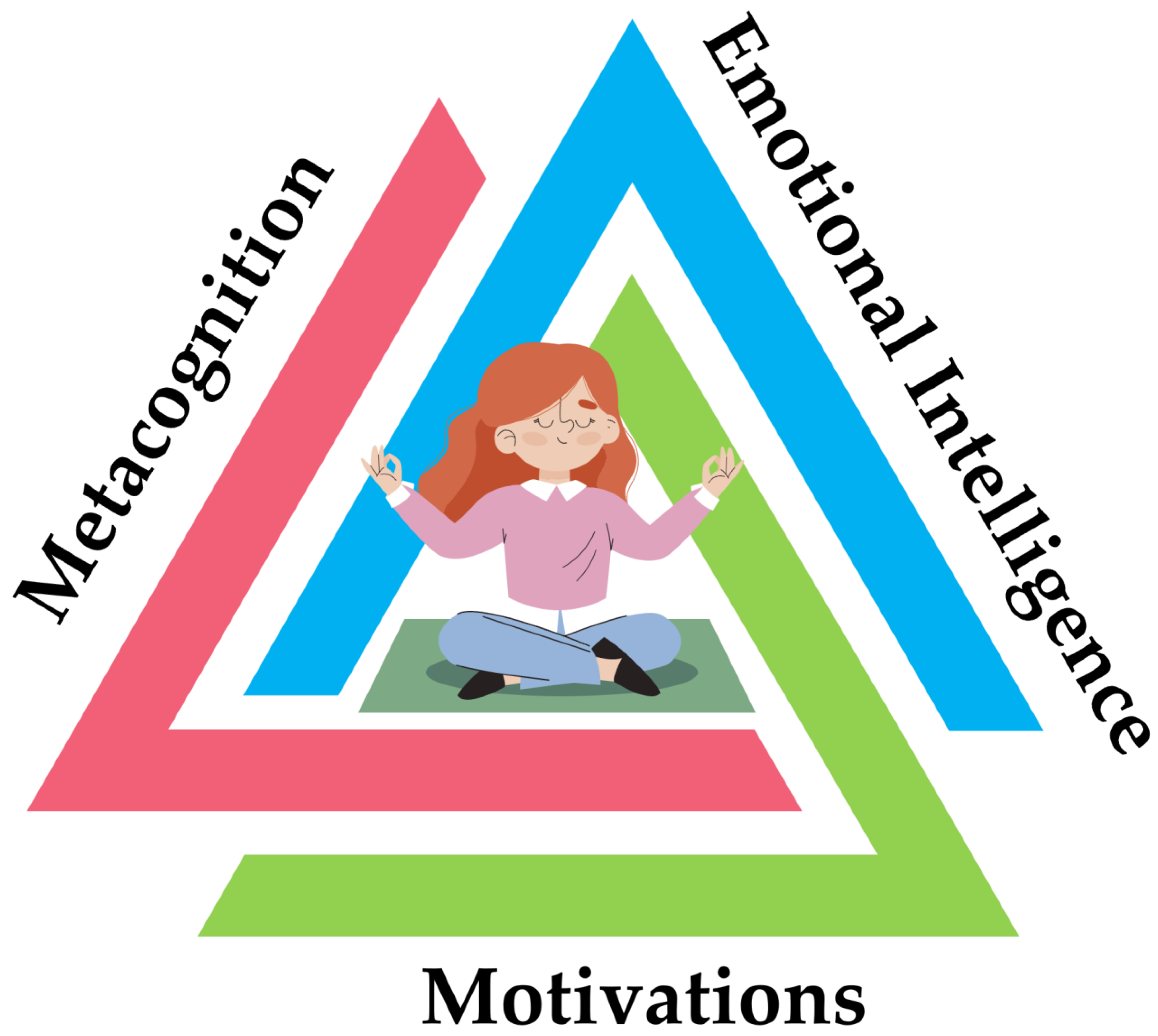
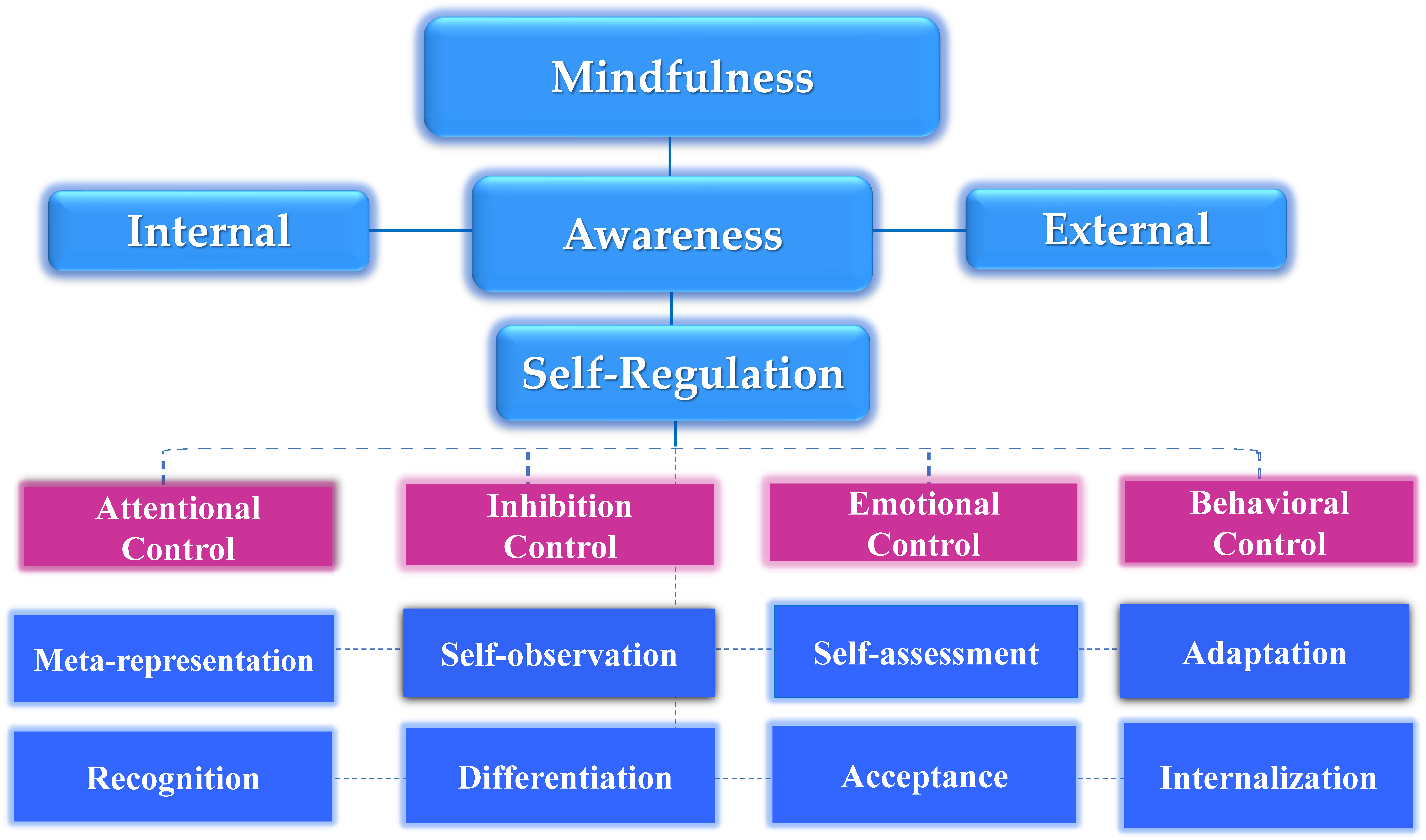
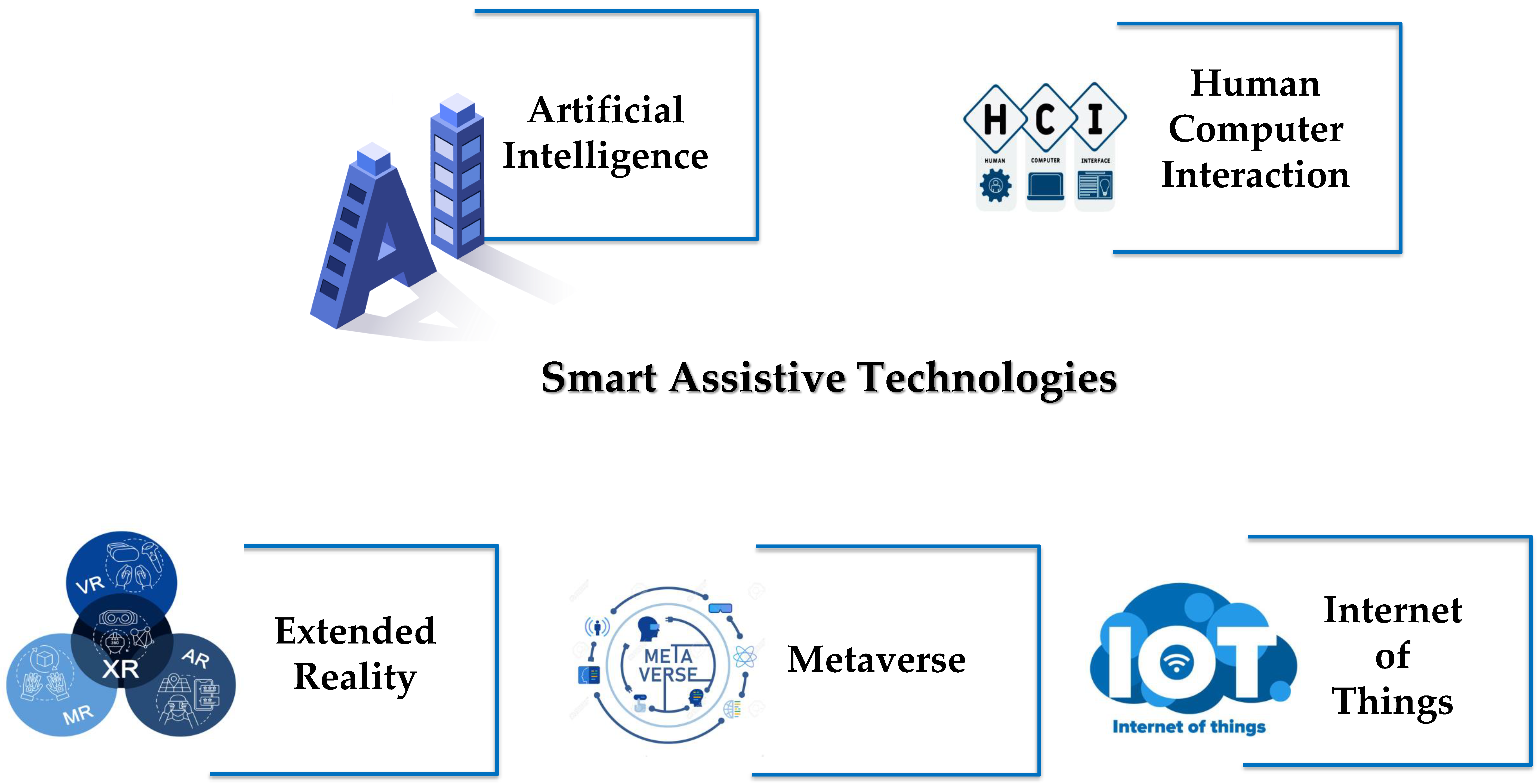
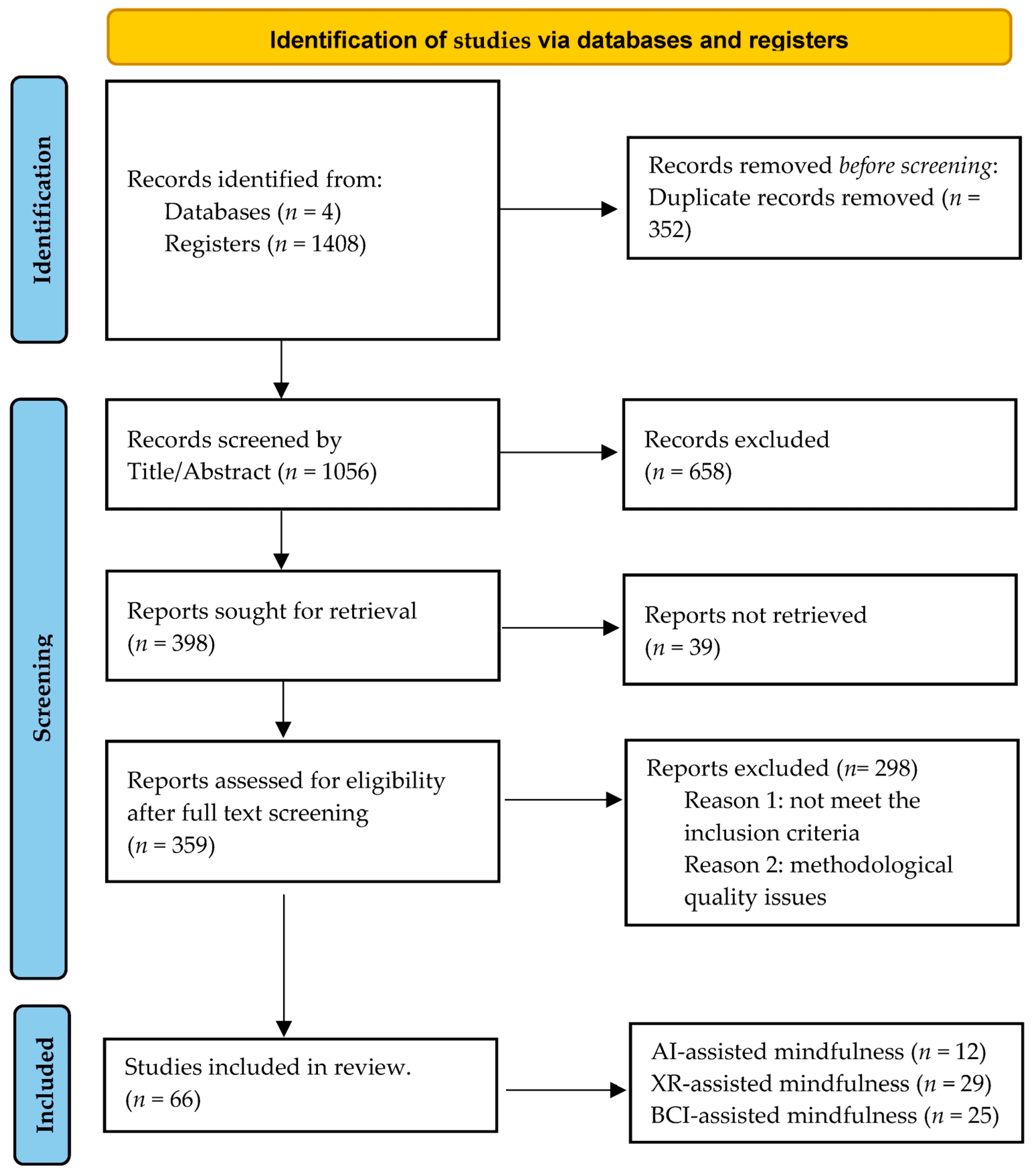
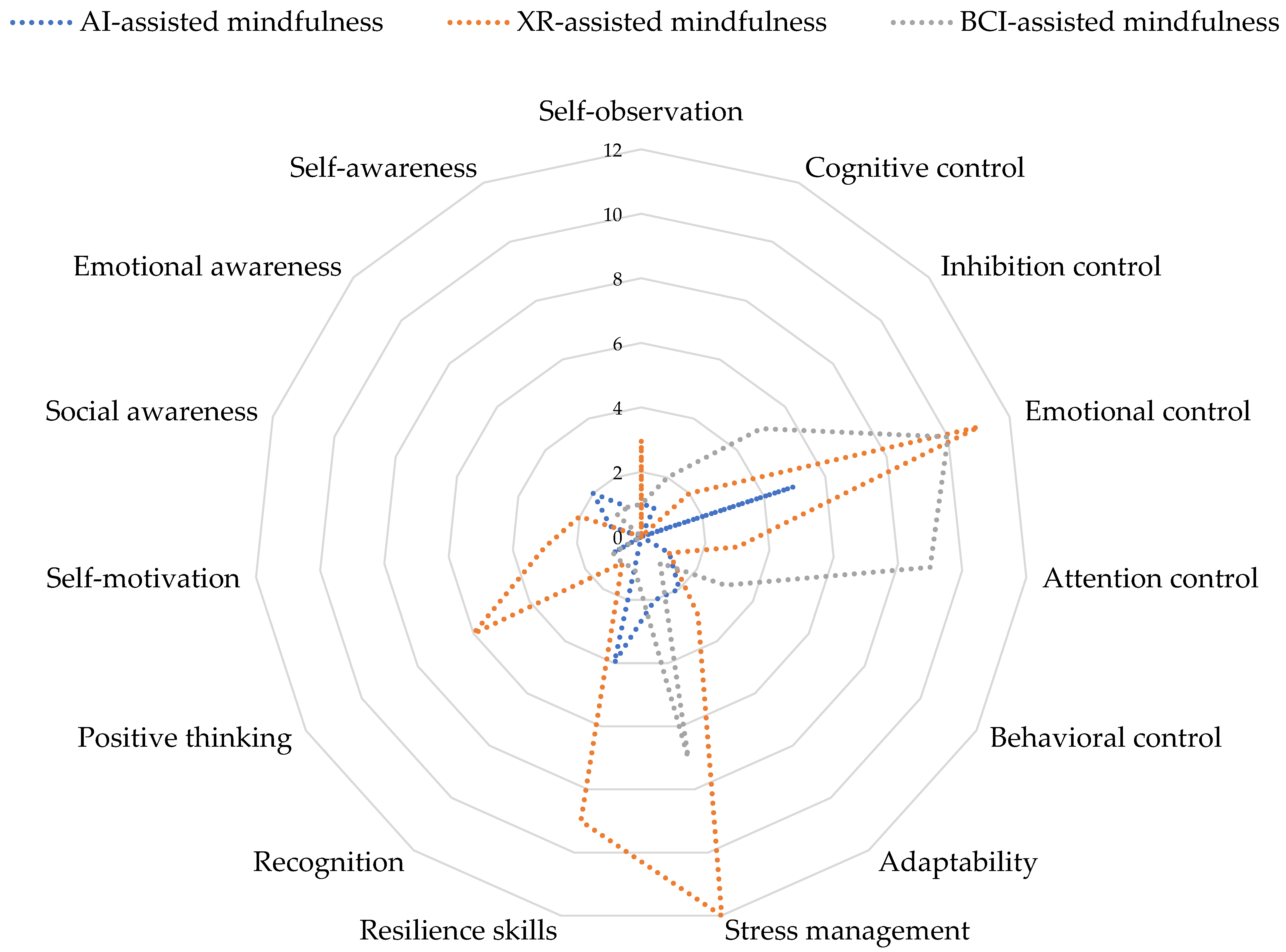
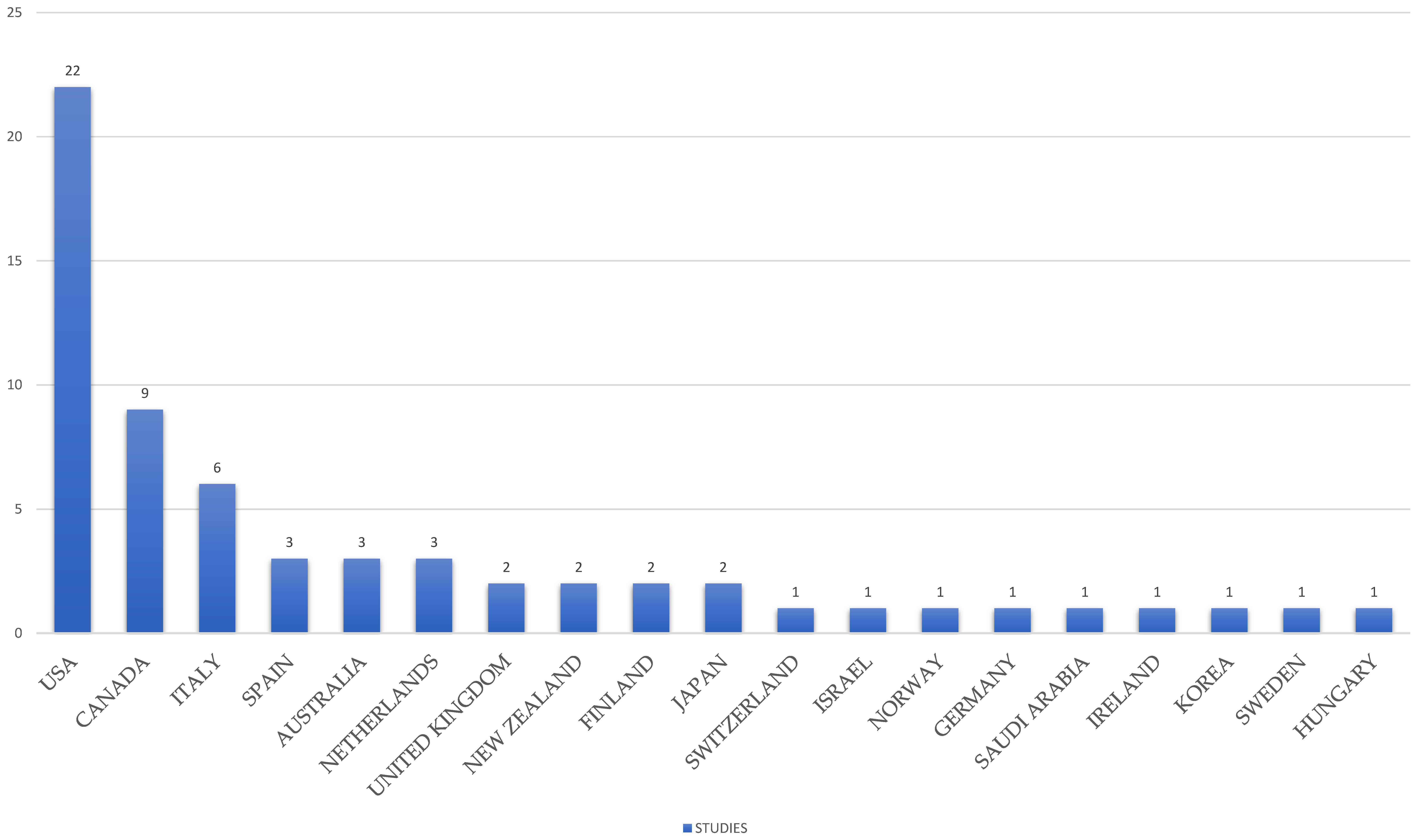
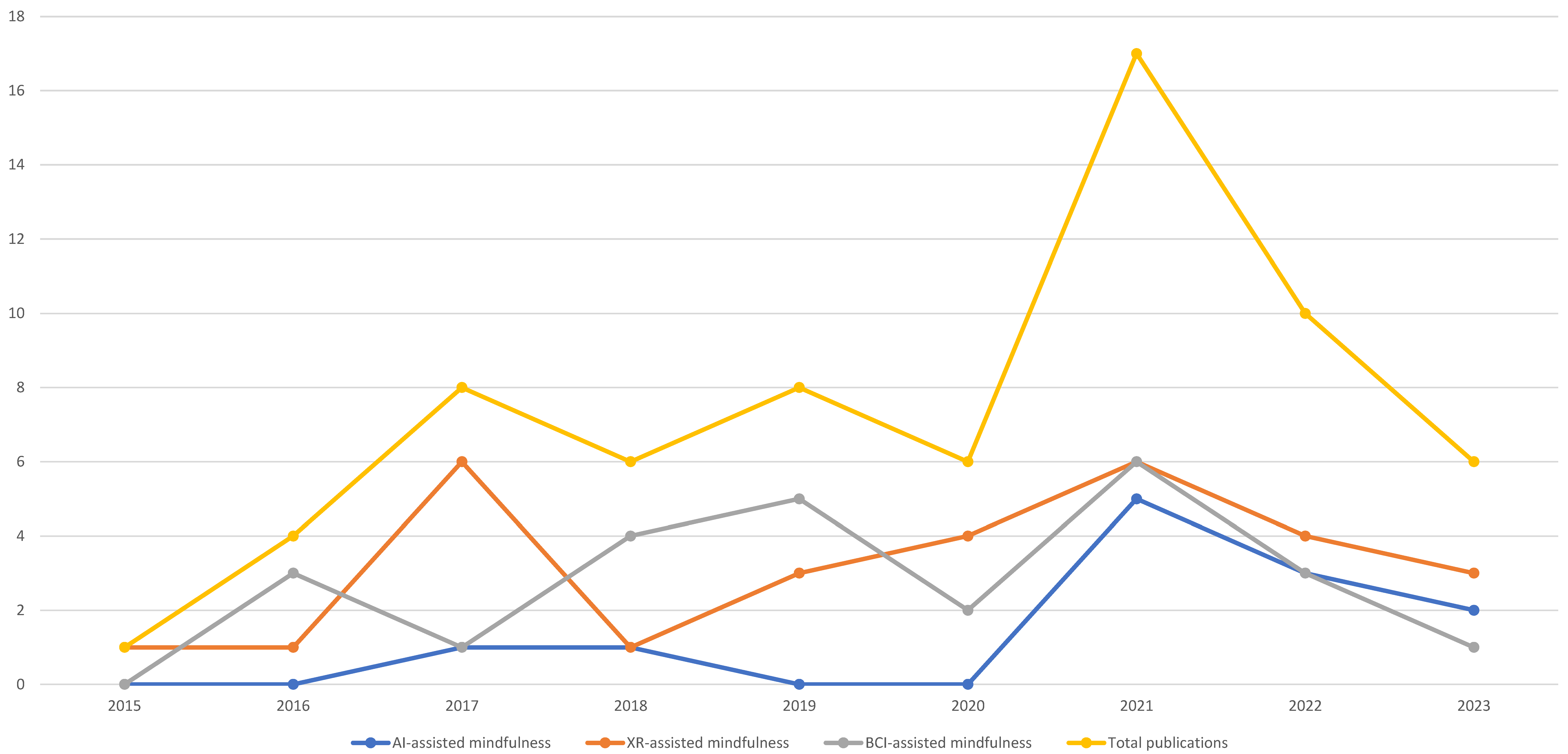
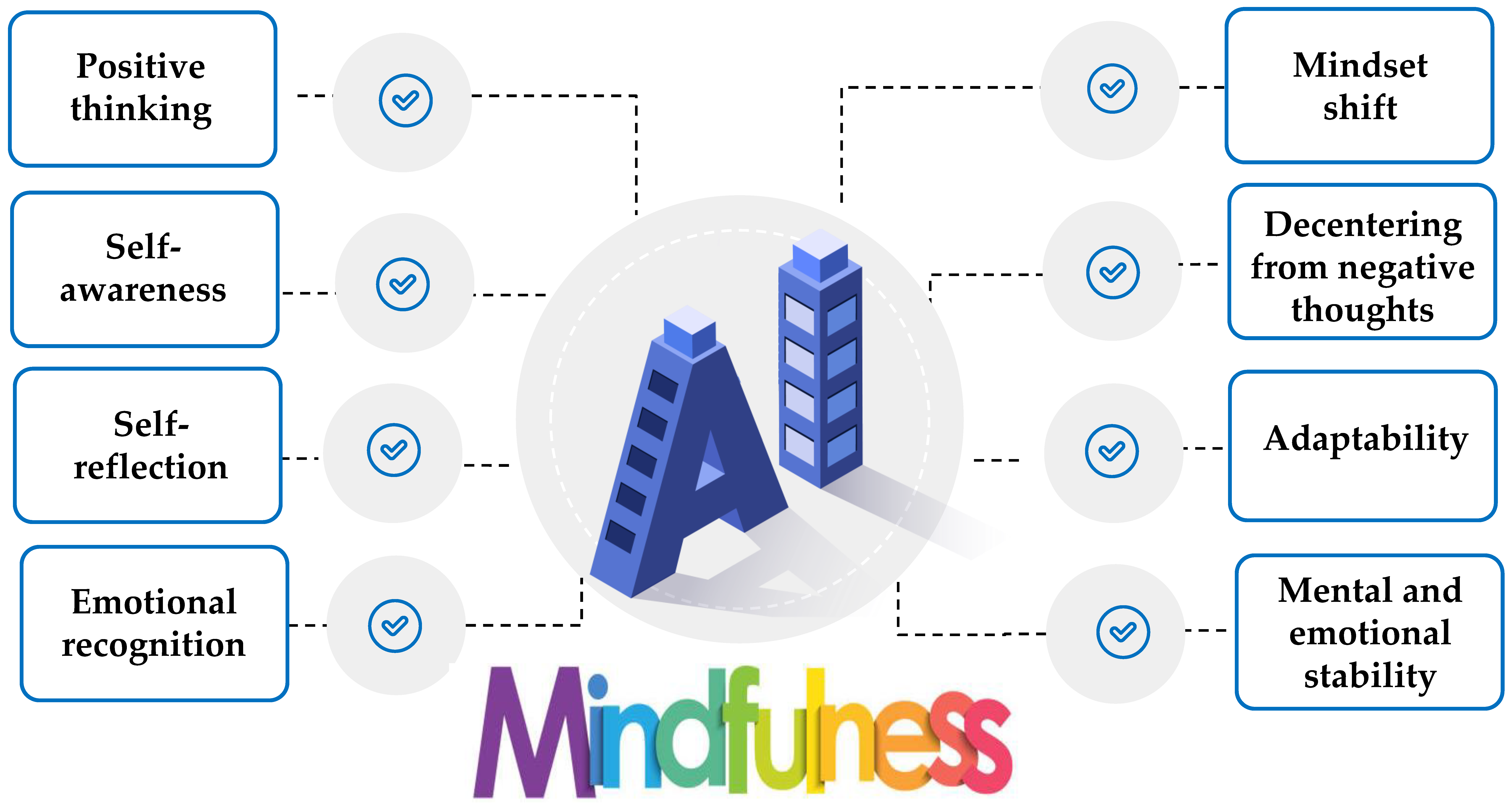
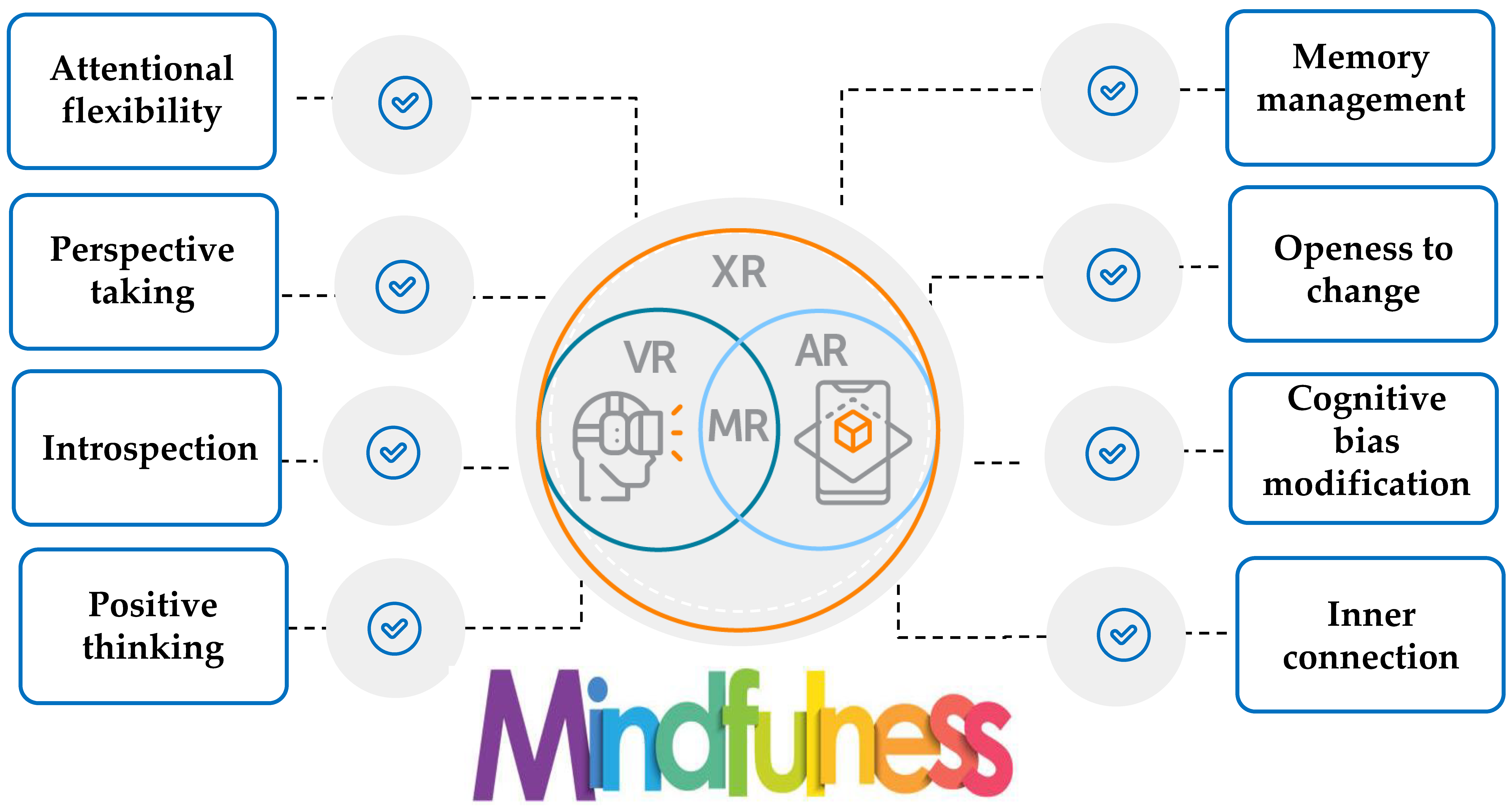
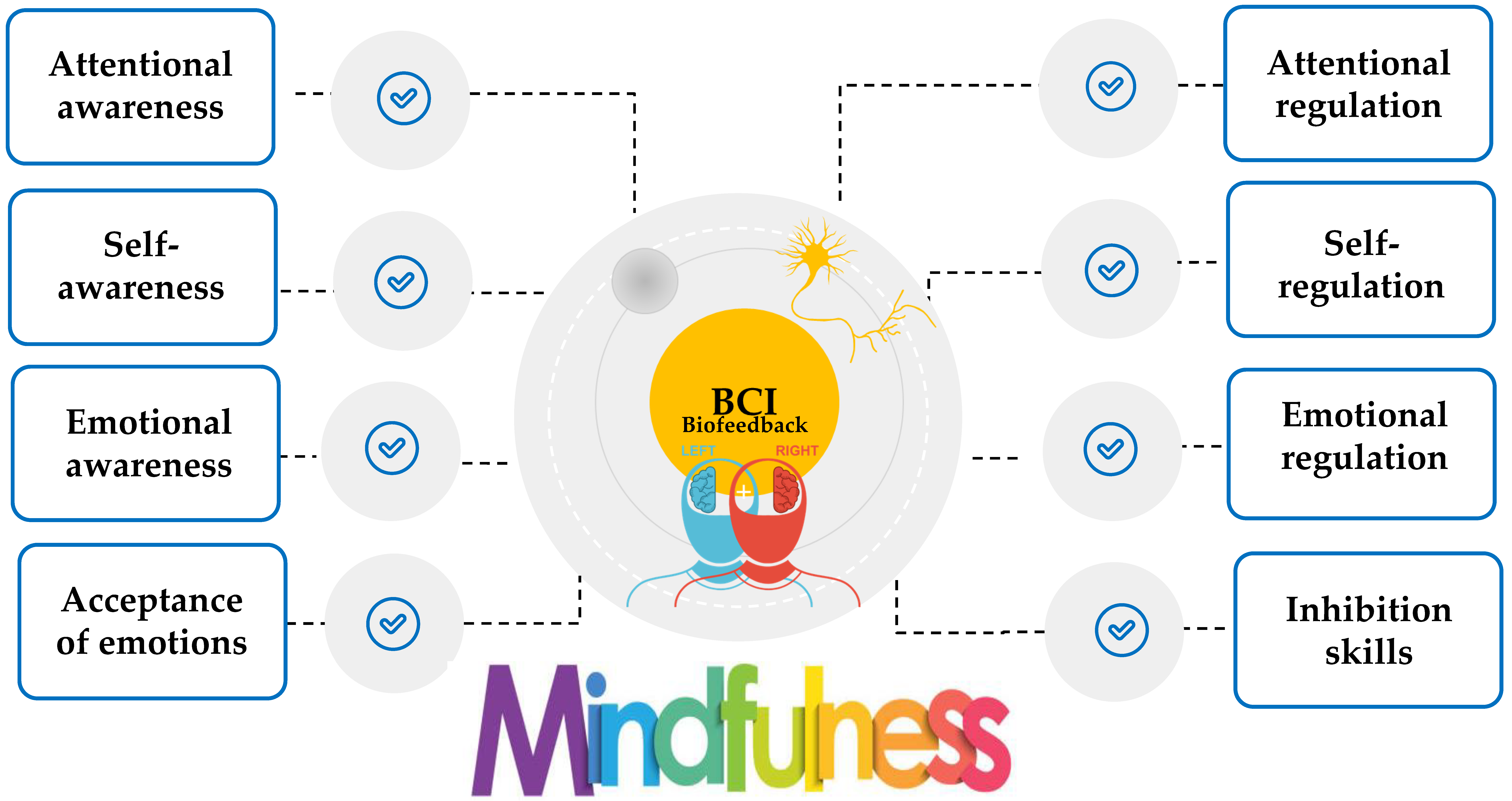
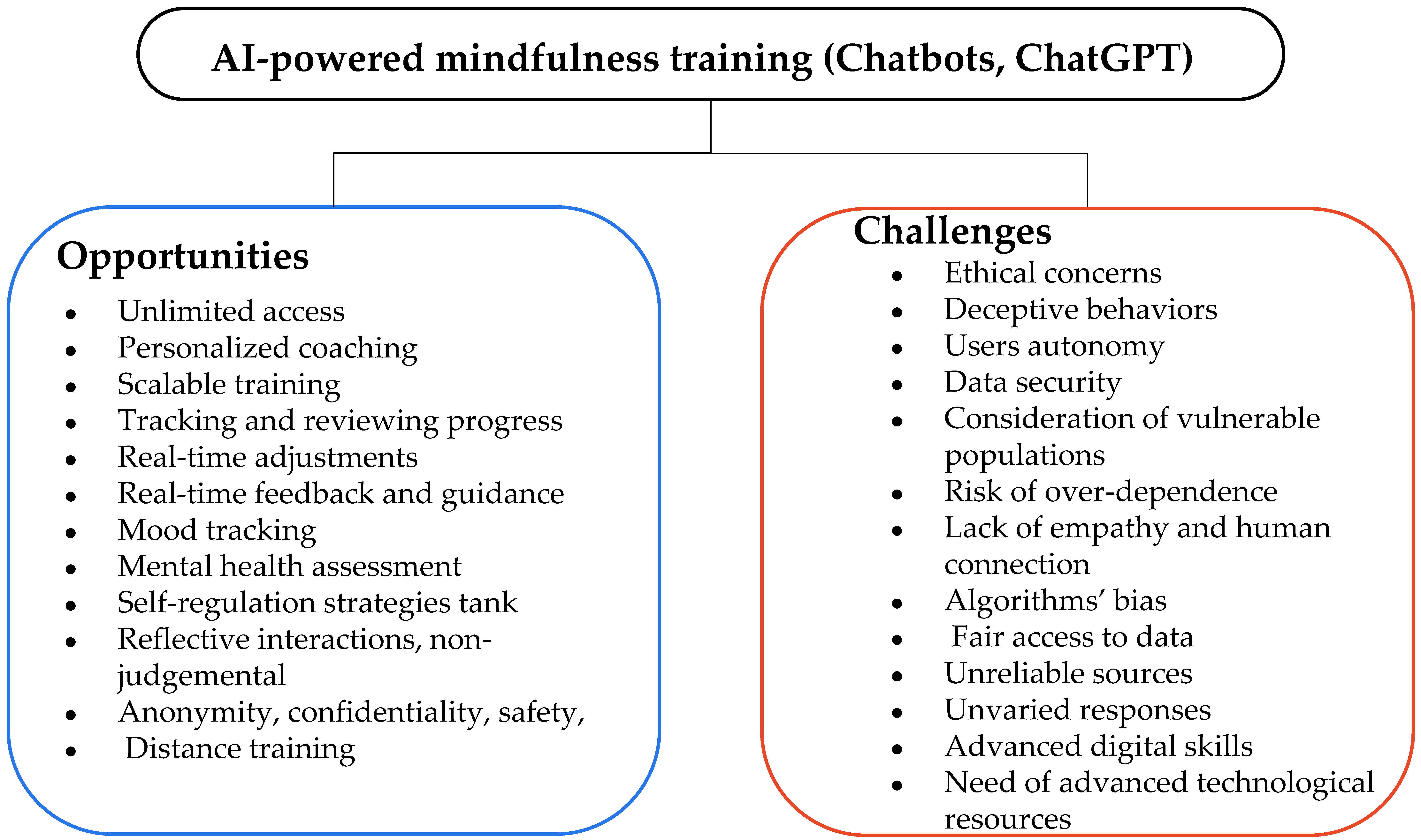
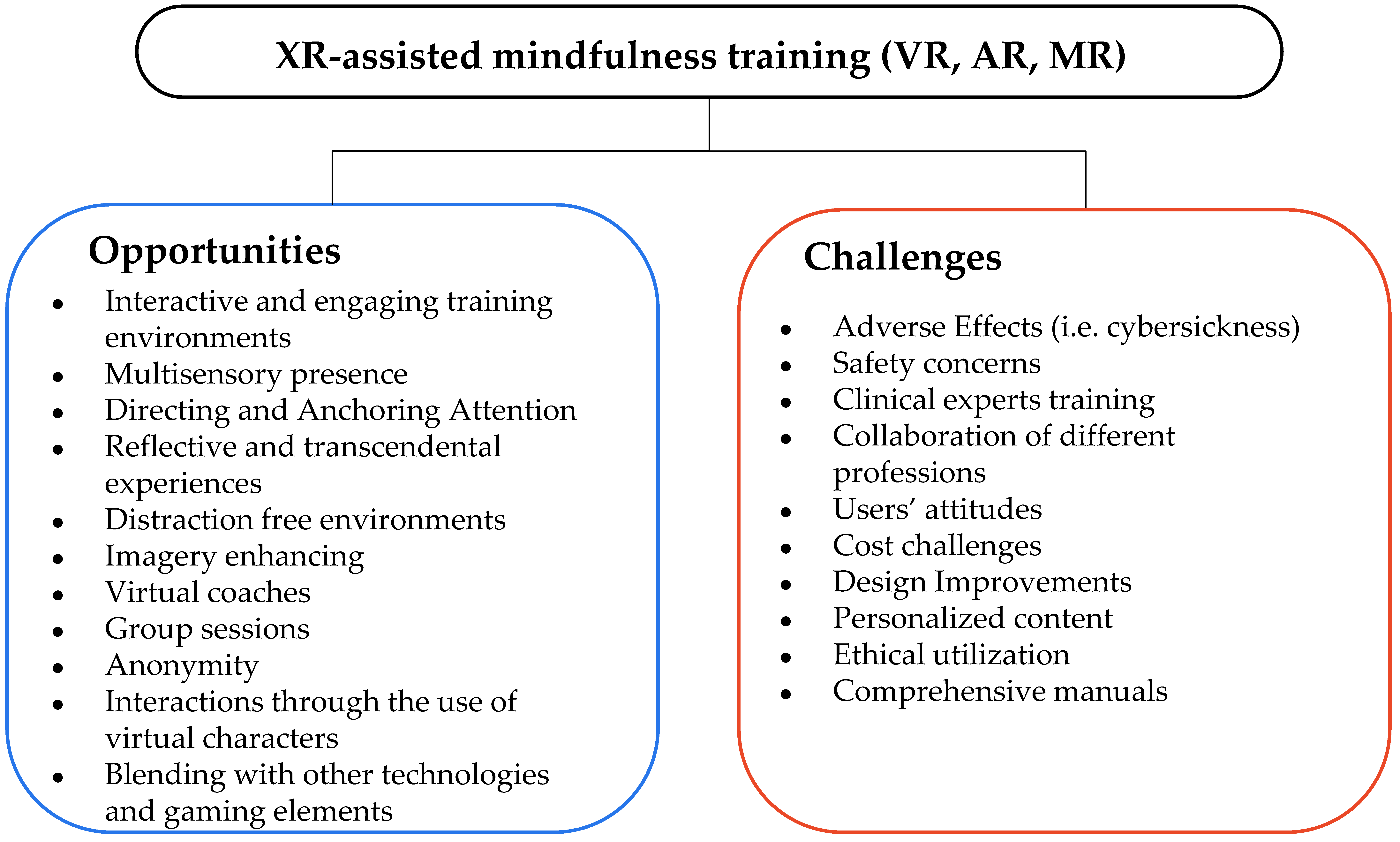
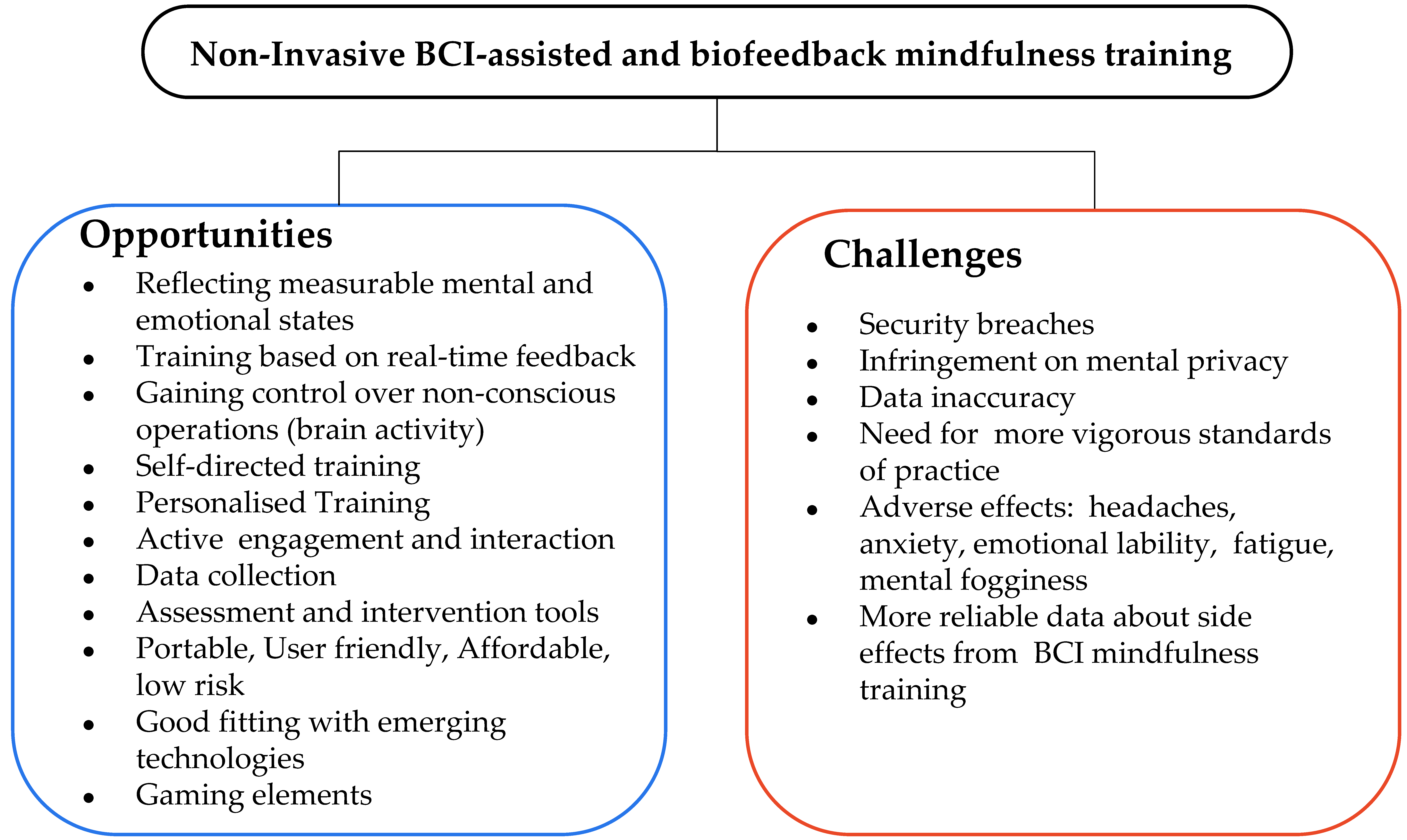

| Inclusion | Exclusion |
|---|---|
|
|
| The Main Searching Keywords in Search Strings |
|---|
| “Mindfulness” OR “meditation” OR “mindful breathing” OR “guided meditation” OR “open monitoring” OR “focused attention” OR “guided imagery” |
| AND |
| “Smart technologies” OR “artificial intelligence” OR “conversational agents” OR “immersive technologies” OR “virtual reality” OR “virtual companions” OR “augmented reality” OR “mixed reality” OR “brain-computer interfaces” OR “biofeedback” OR “metaverse” OR “chatGPT” |
| AND |
| “self-regulation” OR “emotional regulation” OR “self-awareness” OR “emotional awareness” OR “emotional recognition” OR “impulse control” OR “attentional regulation” OR “adaptability” OR “stress management” |
| Domains of Self-Regulation | AI-Assisted Mindfulness | XR-Assisted Mindfulness | BCI-Assisted Mindfulness |
|---|---|---|---|
| Cognitive control | [90] | [91,92] | |
| Attention control | [93,94,95] | [35,92,96,97,98,99,100,101,102] | |
| Impulse control | [66,95] | [35,92,99,101,103] | |
| Emotional control | [90,104,105,106,107] | [66,94,108,109,110,111,112,113,114,115,116] | [13,84,91,102,110,116,117,118,119,120] |
| Behavioral control | [121] | [122] | [92,98,123] |
| Introspection | [106] | [114,115,124] | [13] |
| Flexibility | [125,126] | [108,113,127] | [35] |
| Recognition | [115] | [119] | |
| Emotional awareness | [105,106] | [128] | |
| Self-awareness | [106] | [96] | |
| Social awareness | [105] | [129,130] | |
| Stress management | [105,125] | [114,122,127,129,130,131,132,133,134,135,136] | [100,117,118,120,137,138] |
| Resilience | [36,105,139,140] | [94,108,109,110,127,136,141,142,143] | [144] |
| Positive thinking | [36] | [66,94,111,113,115,129] | [99] |
| Self-motivation | [108,110,113] |
Disclaimer/Publisher’s Note: The statements, opinions and data contained in all publications are solely those of the individual author(s) and contributor(s) and not of MDPI and/or the editor(s). MDPI and/or the editor(s) disclaim responsibility for any injury to people or property resulting from any ideas, methods, instructions or products referred to in the content. |
© 2023 by the authors. Licensee MDPI, Basel, Switzerland. This article is an open access article distributed under the terms and conditions of the Creative Commons Attribution (CC BY) license (https://creativecommons.org/licenses/by/4.0/).
Share and Cite
Mitsea, E.; Drigas, A.; Skianis, C. Digitally Assisted Mindfulness in Training Self-Regulation Skills for Sustainable Mental Health: A Systematic Review. Behav. Sci. 2023, 13, 1008. https://doi.org/10.3390/bs13121008
Mitsea E, Drigas A, Skianis C. Digitally Assisted Mindfulness in Training Self-Regulation Skills for Sustainable Mental Health: A Systematic Review. Behavioral Sciences. 2023; 13(12):1008. https://doi.org/10.3390/bs13121008
Chicago/Turabian StyleMitsea, Eleni, Athanasios Drigas, and Charalabos Skianis. 2023. "Digitally Assisted Mindfulness in Training Self-Regulation Skills for Sustainable Mental Health: A Systematic Review" Behavioral Sciences 13, no. 12: 1008. https://doi.org/10.3390/bs13121008
APA StyleMitsea, E., Drigas, A., & Skianis, C. (2023). Digitally Assisted Mindfulness in Training Self-Regulation Skills for Sustainable Mental Health: A Systematic Review. Behavioral Sciences, 13(12), 1008. https://doi.org/10.3390/bs13121008








